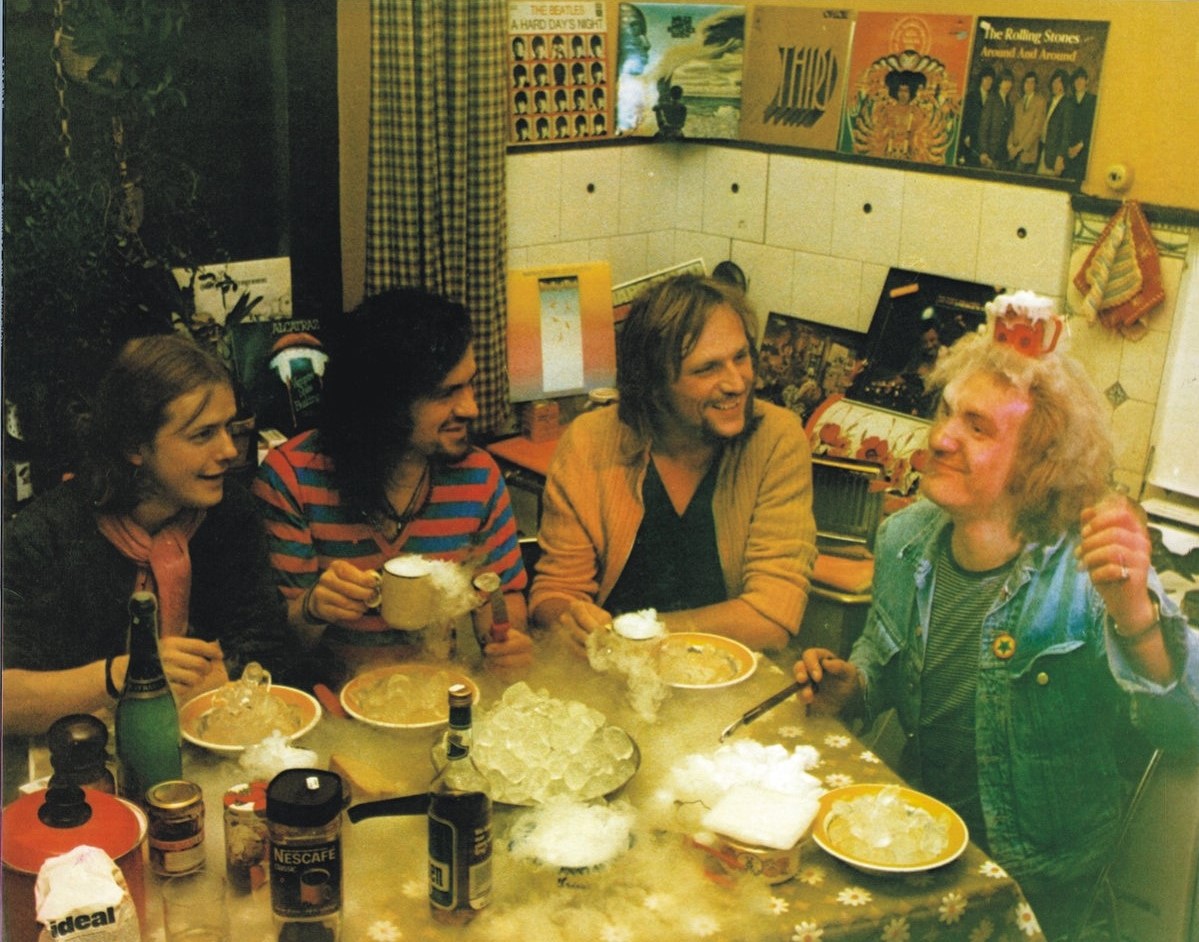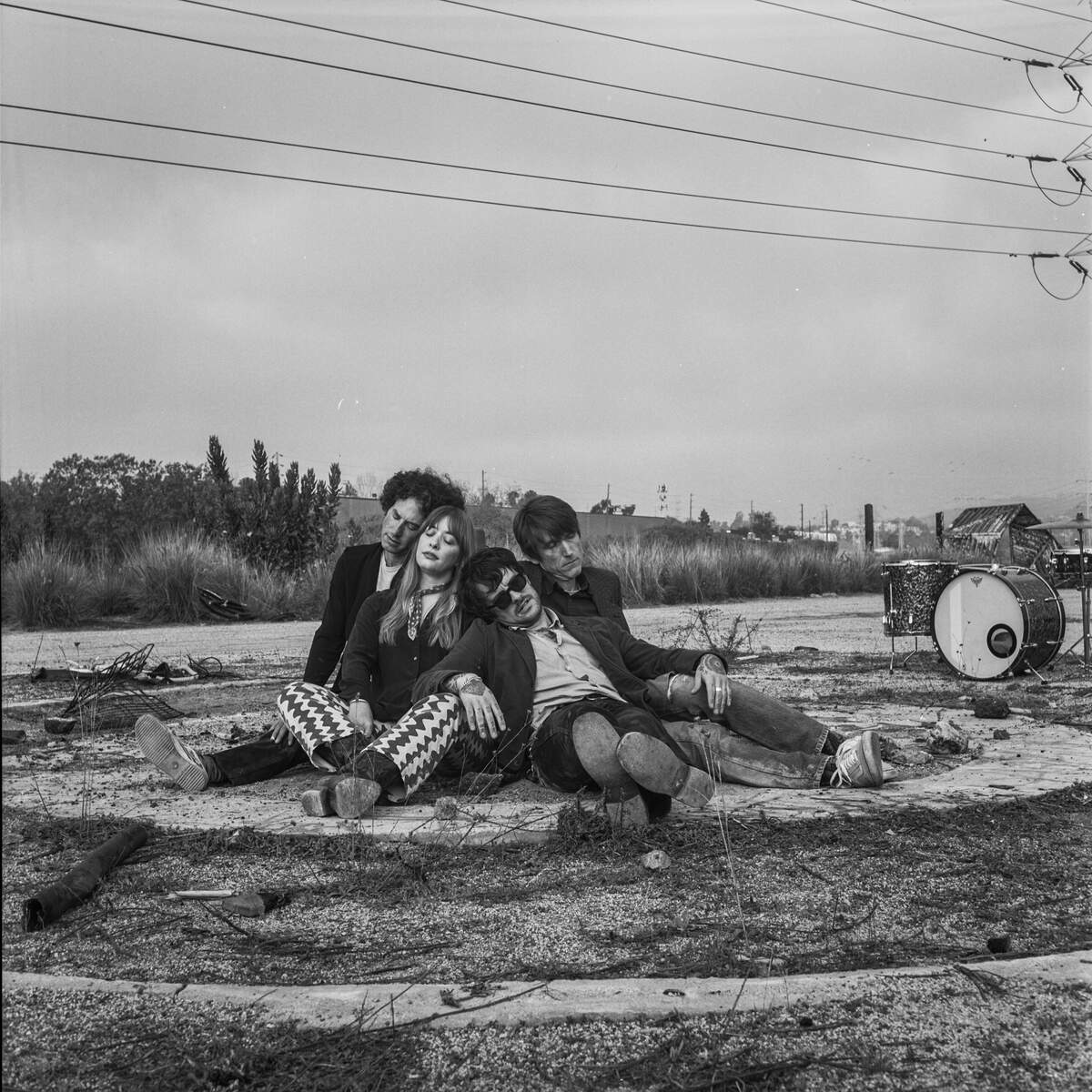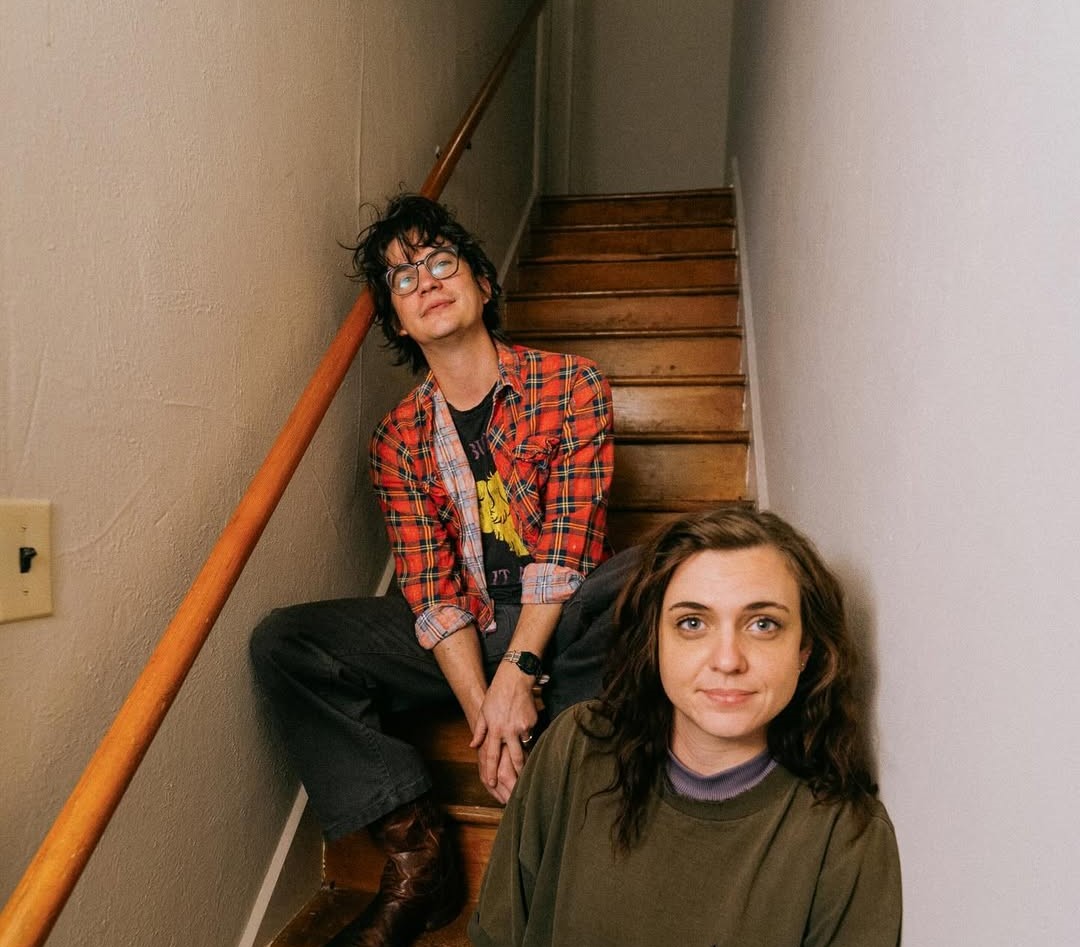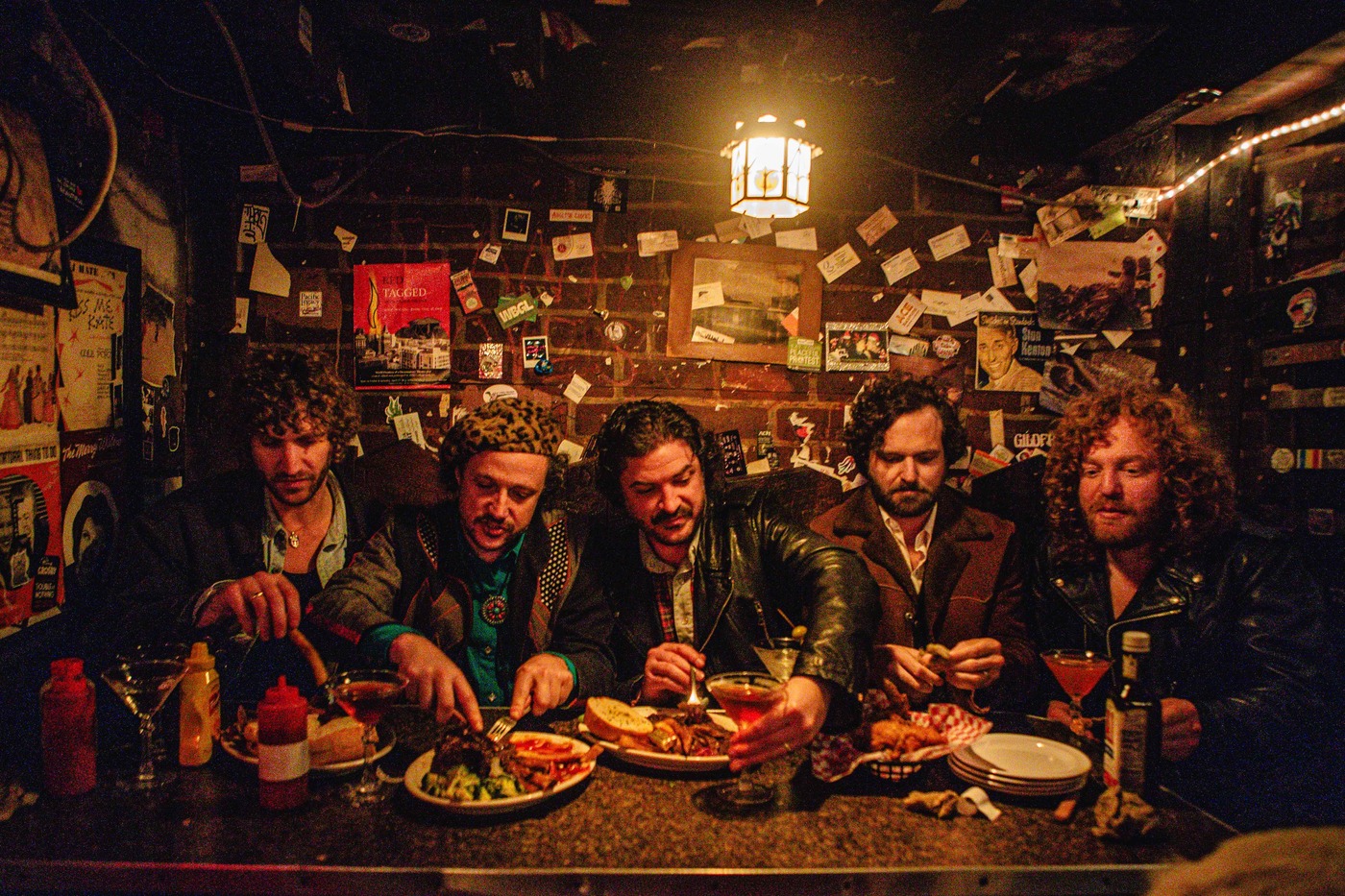Alcatraz | Interview | “Vampire State Building”
Alcatraz was a truly remarkable band formed in the early 70s fusing a variety of styles. Each of their albums is unique in its own way.
The band was founded in the spring of 1970 by Klaus Holst, Rüdiger Berghahn, Ronny Wilson and Jan Rieck. Klaus Nagurski and manager Willy Jahnke joined the band in 1971. Their most well known release is ‘Vampire State Building’ from 1971.
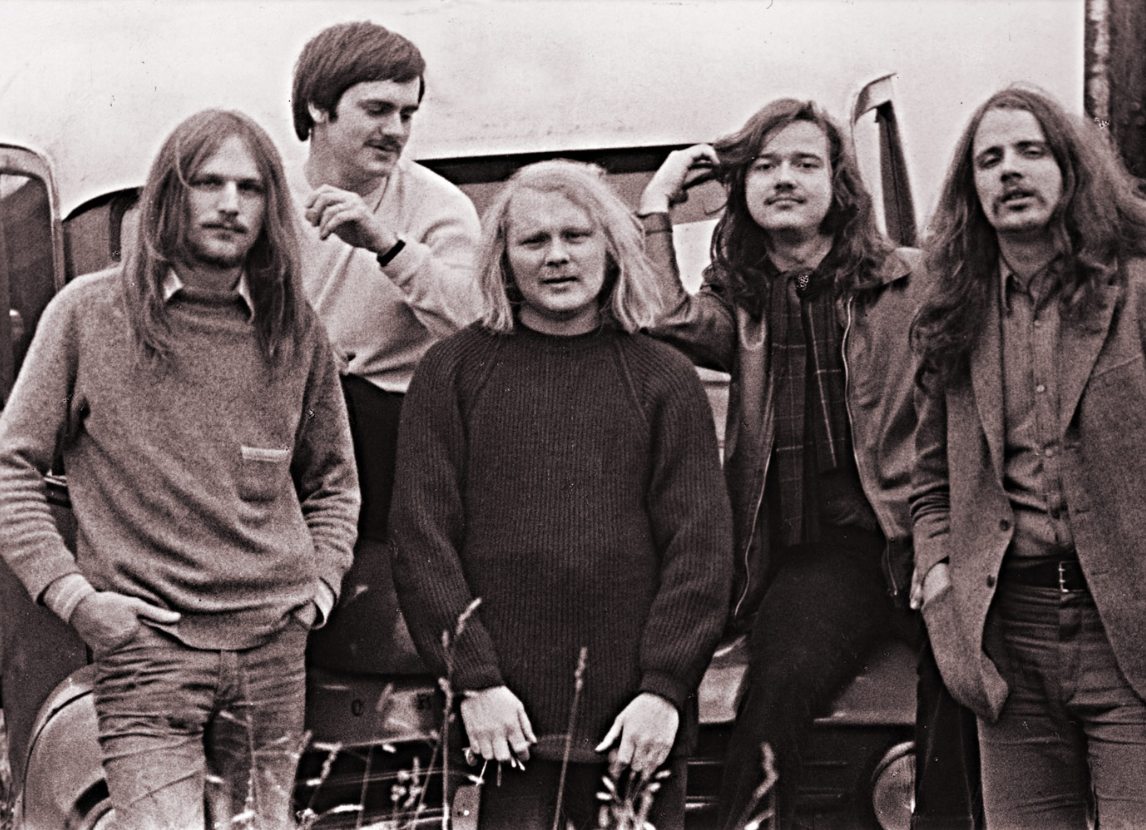
“Our broad spectrum included rock and jazz elements, sometimes combined with Zappa-like weird sequences”
Where and when did you grow up? Was music a big part of your family life? Did the local music scene influence you or inspire you to play music?
Jan Rieck: I was born in November 1950 in Hamburg. My mother was half Cuban and a kindergarten teacher, my father half Italian and a truck driver. So I am by origin only half German, quarter Italian and quarter Cuban. I grew up in a working-class district in Hamburg-Wandsbek for the first seven years. Afterwards my parents moved with me to the Elbe suburbs, because of a job change of my father. Music hasn’t played a major role in my family until then and the local music scene also had no influence on my decision to start playing the drums. This may also be because the German culture, which was excellent and avant-garde until Hitler’s takeover of power in 1933, got completely destroyed and its gruesome effects are still noticeable until today. All great artists from all areas had been expelled abroad as a result of book burnings or landed in a concentration camp. The consequence is that the productions of German entertainment music are, compared to the rest of the world, until today on a low level. We still have the same lame old “artists” that are filling the big venues (Lindenberg, Maffay, Westernhagen, Grönemayer, Fischer et cetera). I had my first experience with music at the age of 12 with the early Beatles (‘Roll Over Beethoven’ and ‘I Want to Hold Your Hand’). The first time I listened to this vinyl was in a record store. I held the two headphones, which looked like telephones just without a microphone, at my ears and was immediately electrified. It was the band-sound of The Beatles that distinguished itself from all other entertainment music. This closed sound didn’t even exist before with American rock and rollers like Elvis Presley et cetera. It quickly became clear to me that the old rock and rollers only cared about the singer, while the accompanying bands just sounded random and void. The English bands turned that upside down at that time. The new thing was the band-sound. A few weeks later I saw The Beatles on TV and I was wondering what Ringo Starr was doing behind there. I knew immediately that I wanted to do just that: play the drums, if possible as a professional. So, I already made this decision at the age of 13 to the chagrin of my parents, because of course, they noticed that from then on, my academic performance was no longer of interest to me.
When did you begin playing music? What was your first instrument? Who were your major influences?
At least I got a small, very cheap drum-set from my parents when I was 14. I started to play it on a daily basis with a tape recorder (Grundig TK 19L) right next to my ear, to simply play along to my favorite English music. Soon my list of favorite bands expanded from The Beatles to other groups like The Rolling Stones, The Animals, The Kinks, The Yardbirds, The Who, The Spencer Davis Group and so on. From 1965 on I started to listen to English blues-rock bands like John Mayall’s Bluesbreakers, Cream, Fleetwood Mac and obviously The Jimi Hendrix Experience. At the age of 16 I saw him for the first time live in the Star Club in Hamburg. I got blown away completely. The drums are since then my first and only instrument, only with the difference that they were very small at that time. It was not until 1968 that I started playing the big double bass drum sets. These sets are still a great physical and musical challenge for me till this day. I never had a single drum lesson, so I self-taught everything just by watching and listening to English and American drummers. In 1965 my drumming was completely influenced by all the English bands I mentioned above. The most important drummer for me at that time was Keith Moon from The Who. Instead of doing my homework at 16, I regularly started to visit the Star Club in Hamburg and other live-music venues, to watch some great bands. As a result of that I started to look up to role models like Carmine Appice (Vanilla Fudge) and John Hiseman (Colosseum).
What bands were you with prior to the formation of Alcatraz?
In 1966-67 I was in a quartet called Memory Lane with three of my classmates. From 1967 until the end of 1969 I played in a group called Jet Set Blues Band. With this band we already made numerous appearances, mainly in youth centers, community centers and school festivals.
“Our musical direction was inspired by the since 1967/68 dominant underground”
Can you elaborate on the formation of the band?
In the spring of 1970, we founded Alcatraz. Our musical direction was inspired by the since 1967/68 dominant underground and fusion-bands like Frank Zappa, Soft Machine, The Remo Four, Keef Hartley Band and Colosseum, from which we took over pieces or elements. In March 1970 we became a quartet: Klaus Holst (lead guitar), Rüdiger Berghahn (piano and vocals), Ronny Wilson (bass and b-vocals) and me on the drums. Around the turn of the year 70/71, Klaus Nagurski (tenor saxophone, flute) joined us, as well as the Manager Willi Jahnke, who pointed us straight into a professional direction. While we often played at the same venues as the Jet Set Blues Band with the quartet, Willy Jahnke gave us the opportunity to play gigs all over Germany. Partly in large event halls, city theaters and big cinemas. At this point we were already the opening act of bands like Harding & York, Ekseption, The Pretty Things and Kraftwerk.
“As we became a quartet, we started to play almost just our own music”
When and where did Alcatraz play their first gig? Do you remember the first song the band played? How was the band accepted by the audience? What sort of venues did Alcatraz play early on?
The first Alcatraz gig took place in a church parish hall. At that time, those houses often hosted rock-events with local bands for the local youth. The second concert we played was in a border village to the former GDR, called Helmstedt. It was an open-air band contest and I remember that the stage had no roof and we had to play in pouring rain. Every time I hit the toms or the snare drum, the water splashed against me. Rüdiger Berghahn could have floated a paper boat underneath his e-piano. Nevertheless, we finished the competition as winners, just ahead of a band from Bremen. On the other hand, we slightly cheated on collecting the ballots from the audience. The first Alcatraz song, if I remember correctly, was ‘Sinning For You’ from the Keef Hartley Band, a blues-like composition in a shuffle rhythm. But as soon as we became a quartet, we started to play almost just our own music.
How did you decide to use the name “Alcatraz”?
I think the name was suggested by Rüdiger because of our solidarity with the Sioux Indians, which occupied the island of Alcatraz in California in 1964 and 1969. They demonstrated to ensure the compliance the US Government granted them in their contracts.
What influenced the band’s sound?
Our sound has always been influenced by international bands with their various styles like prog, fusion and/or underground. We always went to those concerts. Very quickly we started to get into jazz music, which also influenced us in our way of creating music. Artists we listened to were Miles Davis, Carla Bley, Larry Coryell, John McLaughlin, Weather Report.
Did the size of audiences increase after the release of your debut?
It is always important for a band on tour to offer an LP with their current program. The work with Willy Jahnke plus the ‘Vampire State Building’ LP led automatically to more gigs and a larger audience, which was clearly noticeable.
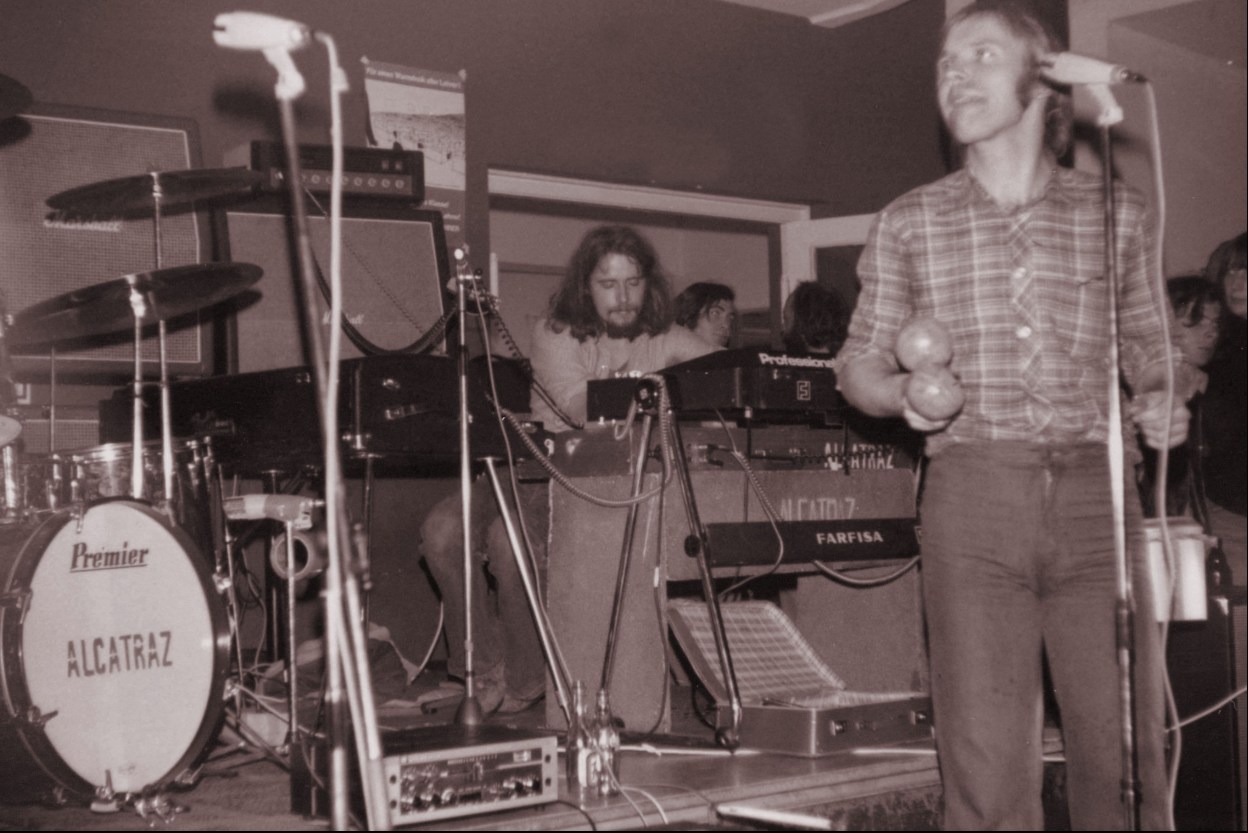
How did you get signed to Philips?
Willy Jahnke contacted a producer from the German classical music label Deutsche Grammophon. This Producer (Jimi Boyks) brought us into a studio in October 1971. Later, when the LP was mixed, Boyks sold the production to Philips and changed it with his employer. He immediately got a job as a producer at Philips.
How many copies of the first album were pressed?
I don’t remember exactly, I think it was 3000.
What’s the story behind your debut album? Where did you record it?
We did what we had planned for our first LP: We recorded exclusively our own compositions. We recorded them in three days (07. – 11 October 1971), at least 10 hours a day including technical settings. All the recordings were made in a studio called Wümme in a small town in Lower Saxony. The equipment we used was our own back line (Marshall-amps, Premier-drums, Gibson-guitar, Fender-bass) as well as the recording equipment of the studio. The producer was Jimi Boyks.
Please share your recollections of the sessions. What were the influences and inspirations for the songs recorded?
Of course, those influences also came to bear on our own pieces on this LP. The realization of the sessions themselves was sometimes very anarchistic with all that nonsense we did as young men. There was one scene during the second recording day that we will never forget: I was recording the drum-solos, and after a few minutes a big curious face of a German shepherd appeared right behind my toms and began to fixate on me. Behind the dog stood two policemen, one with a pistol pointing at me and the other one even with a submachine gun. I stopped playing and raised my hands as a precaution. It turned out that the entire task force consisted of 12 armed police officers. They received a tip from a local, that in the studios are some young longhaired guys who are part of the RAF / Baader-Meinhof Group. They already arrested the drummer of the underground band Faust, which was recording in the second studio of the building, because he had no ID on him. Fortunately, we had our ID’s with us and were left alone after one hour of individual interrogation.
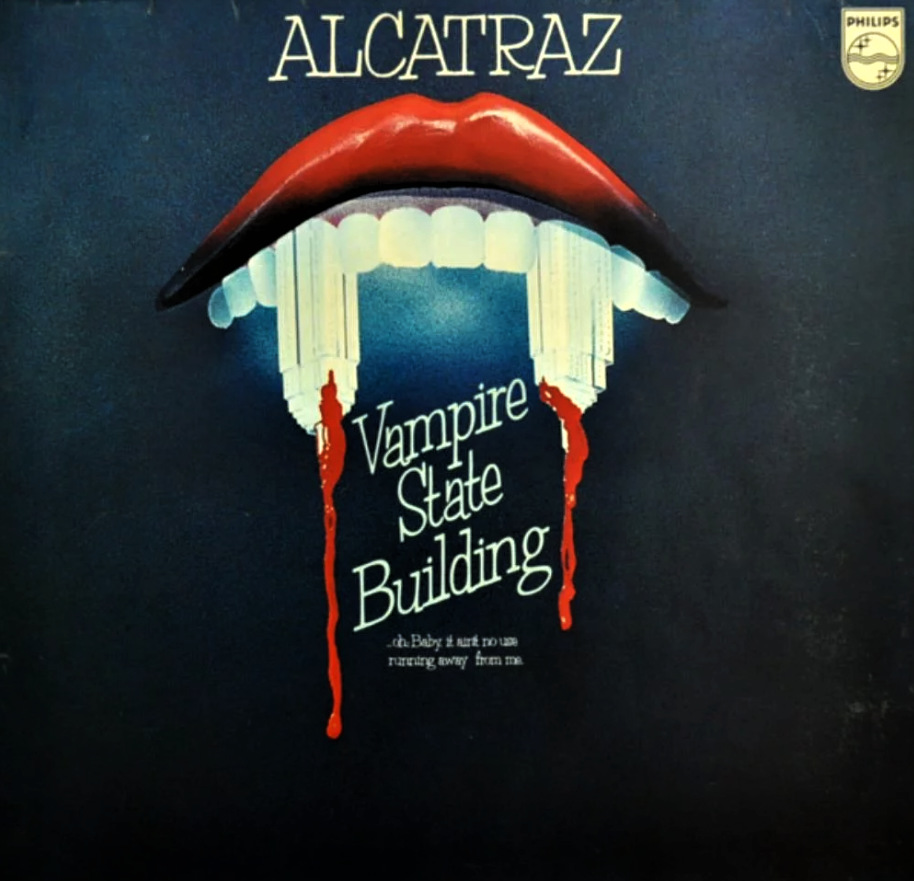
Would you share your insight on the album’s tracks?
In my assessment of the artistic direction of the tracks and their compilation must be considered that this is 47 years ago now. I was 20 at that time and the other members were between 18 and 22 years old. From this perspective, I’m still pretty satisfied with the set, especially since we have also performed this music live. In 2002, the company Long Hair Music, which is committed to re-publish old krautrock recordings, re-released the first Alcatraz LP ‘Vampire State Building’ on CD. We released a bonus track called ‘Change Will Come’ on it. We recorded this and some other tracks with a different bassist in 1972, one year after we finished ‘Vampire State Building,’ in a studio in Hamburg. The producer was Jochen Petersen, who became rich a few years later with his composition ‘Sun of Jamaica’ … that’s how different worlds sometimes meet. On ‘Change Will Come’ you can already see a clear development: The composition is much more versatile, playful and sound-technically more compact. In retrospect I’m glad that this track was made public again this way.
How pleased was the band with the sound of the album? What, if anything, would you like to have been different from the finished product?
The guitar and bass on ‘Vampire State Building’ sounded way too flat for our taste. Also, the drums, especially the bass-drums and toms sounded too much like garage-sound. At that time, we already sounded much better live. On the other hand, that didn’t drown out the pride we felt back then about our first LP being released.
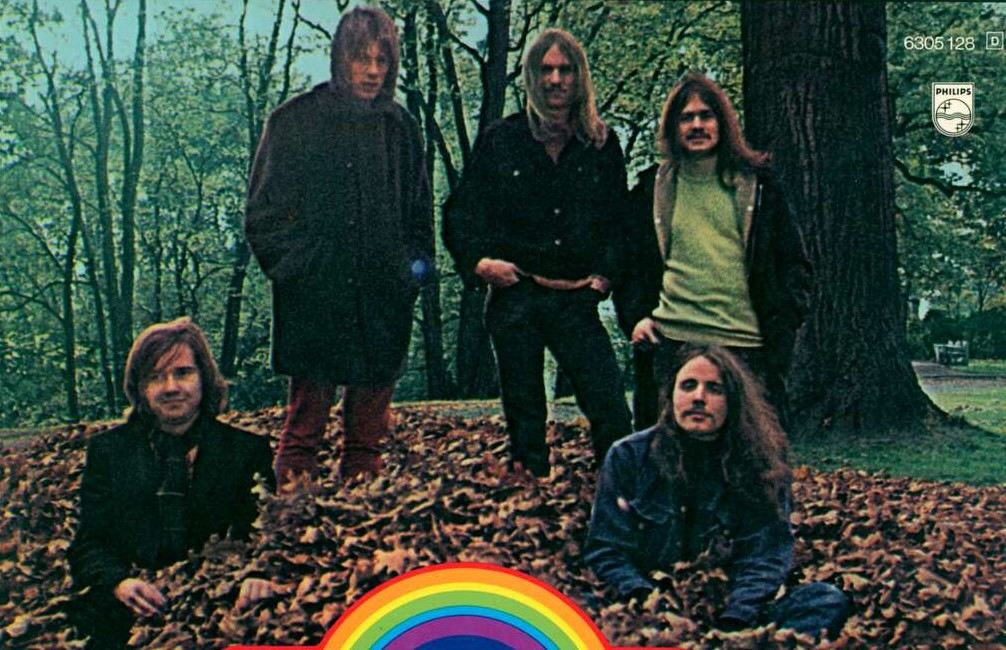
Was there a certain concept behind the album?
It was important to us to bring the entire stylistic that we already had, onto vinyl. Our broad spectrum included rock and jazz elements, sometimes combined with Zappa-like weird sequences. You can hear these especially in the title song ‘Vampire State Building,’ mostly in the middle instrumental parts. That was already very avant-garde for German bands back then. With those parts we completely separated ourselves from the casual krautrock, which we didn’t want to belong to anyway.
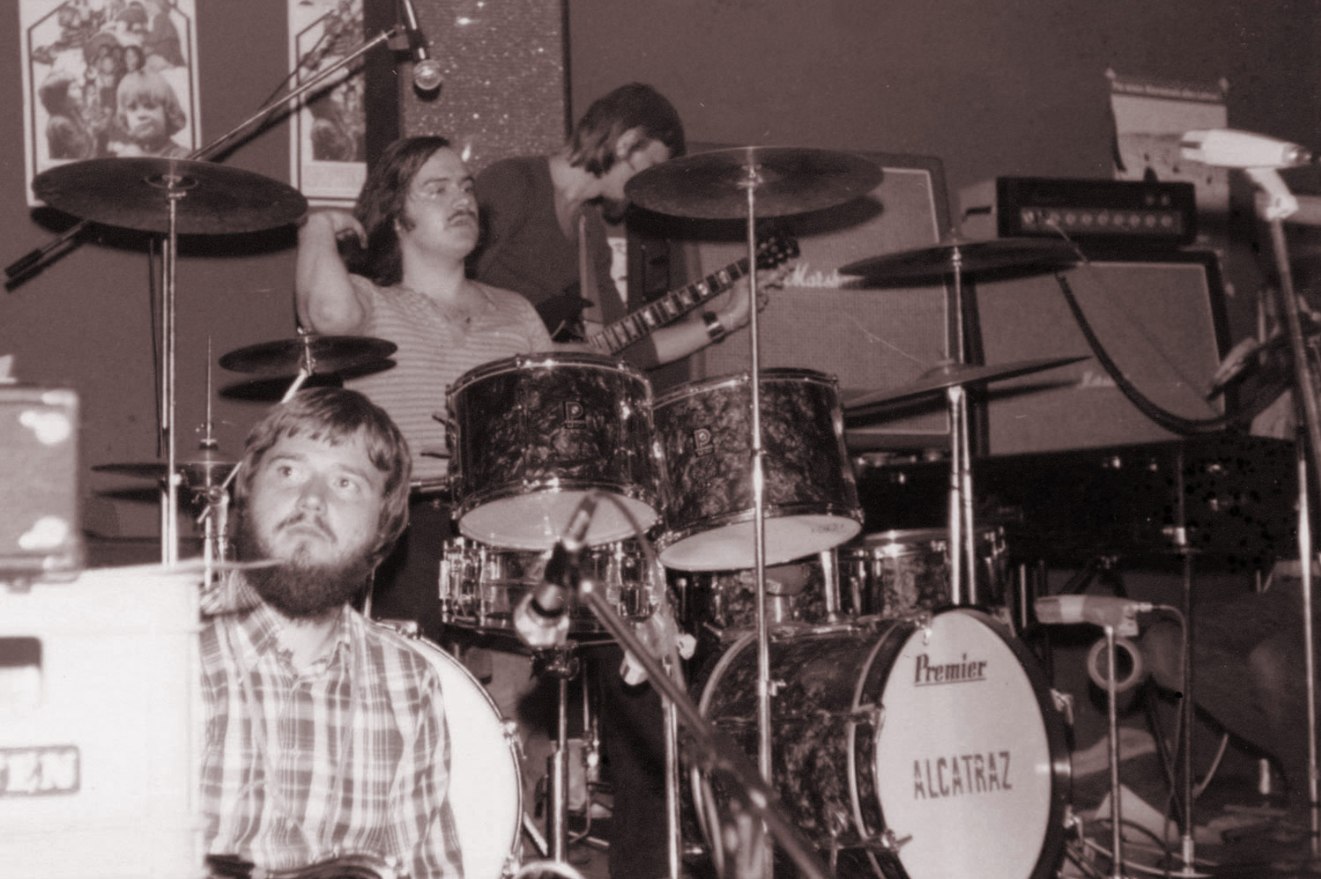
How about your second album ‘Energie-Programm in Rock’? It’s full of social commentary.
In the meantime, we found a good live recording from 1976 on tape which was recorded in a youth club. We often had to change the lineup of the band, at least partly, because some Alcatraz members built up their own bands. That’s why this tape is recorded with partly new members (Klaus Hormann – bass, Thomas Hockling – vocals and harmonica) or with recently returned musicians (Klaus Nagurski – saxophone and flute). Still in the band were Klaus Holst (guitar), Rüdiger Berghahn (vocals and piano) and me. So this time we were a sextet. We mixed the material way later and released it as a live CD with the title ‘Made in Germania’. So basically, this CD is our second album if you watch it historically. You can already hear the first German lyrics in these tracks. These were already partly socio-politically, especially directed against the right-wing filth in Germany and the cultureless philistinism we met with Alcatraz over and over. On top the music in 1976 had a very strong direction: sound, arrangements, own compositions, polyphonic vocals and also a lot of instrumental-soloistic which was relatable to Tony Williams Lifetime, Chick Corea, John McLaughlin, Zappa…, yet with some touches of cabaret.
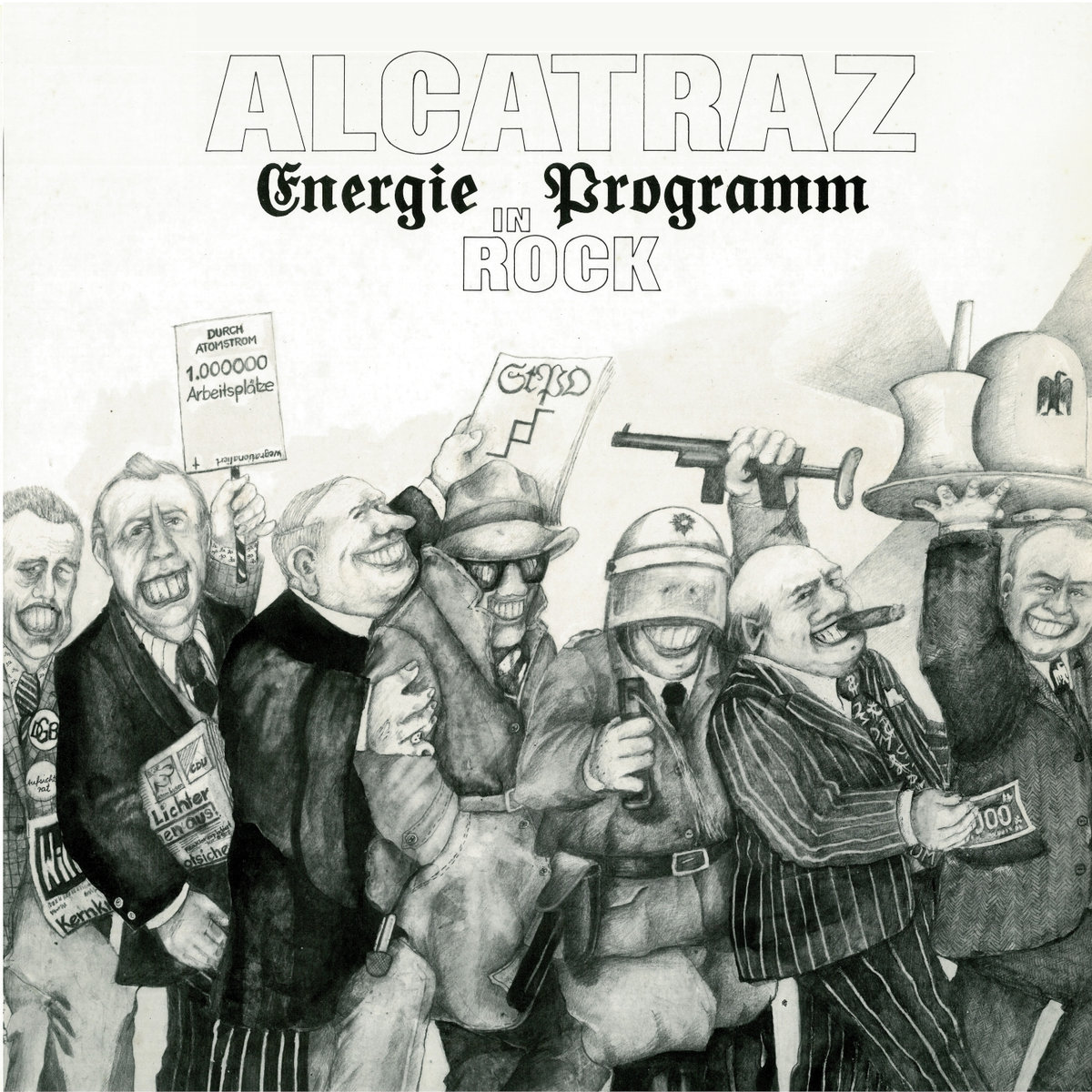
We released ‘Energie-Programmim Rock’ two years later in 1978 as a studio production with a quartet (Holst, Berghahn, Rieck) plus Ed Schulze on the bass. We recorded with this new lineup for several reasons. Hormann started a new rather rock-pop band, Nagurski changed to the Hamburger Philharmonie as he had finished his woodwind instrument studies and Hockling moved to Bavaria due to professional reasons. Since the new member Schulze played the bass a bit simpler than his two predecessors, and because we wanted to go further against nuclear power plants in terms of political lyrics, the musical orientation also slightly shifted. With this anti-atom-program we toured about a yearlong through Germany. We often played at demonstrations and political gatherings of the left-wing scene.
What are some of the strongest memories from preparing songs for the second album?
The compositions were mostly created by Holst. Berghahn and I wrote almost all the lyrics in German, which were then sung by Berghahn. These texts have been arranged by us into an overall concept. This concept had a logical order that unmasked the mendacity of German nuclear operators and their bought politicians. That’s why we kept the sequence of the record when we performed live, often in front of a huge left-political audience. It was like some kind of rock-opera. We had to work very seriously on this overall concept with its repeated reorganizations during the preparation phase. We then recorded the LP in our rehearsal room with a friend, Kalla Wefel, who played in the band “October” from Hamburg. He built in his studio equipment for us and then took over the mix of the record.
Would you share your insight on the album’s tracks?
As already mentioned, the defined concept flow was important here. We even worked with the Hamburger Eingreif-Theater for a couple of weeks, to work out a music drama. They were kind of a left-wing street theater that also often performed at demonstrations and political protest events. But in the end, it didn’t work out as we imagined it as the theater people were not able to deal with this kind of music. Anyhow we performed it together, them as a theater and us playing along as a band.
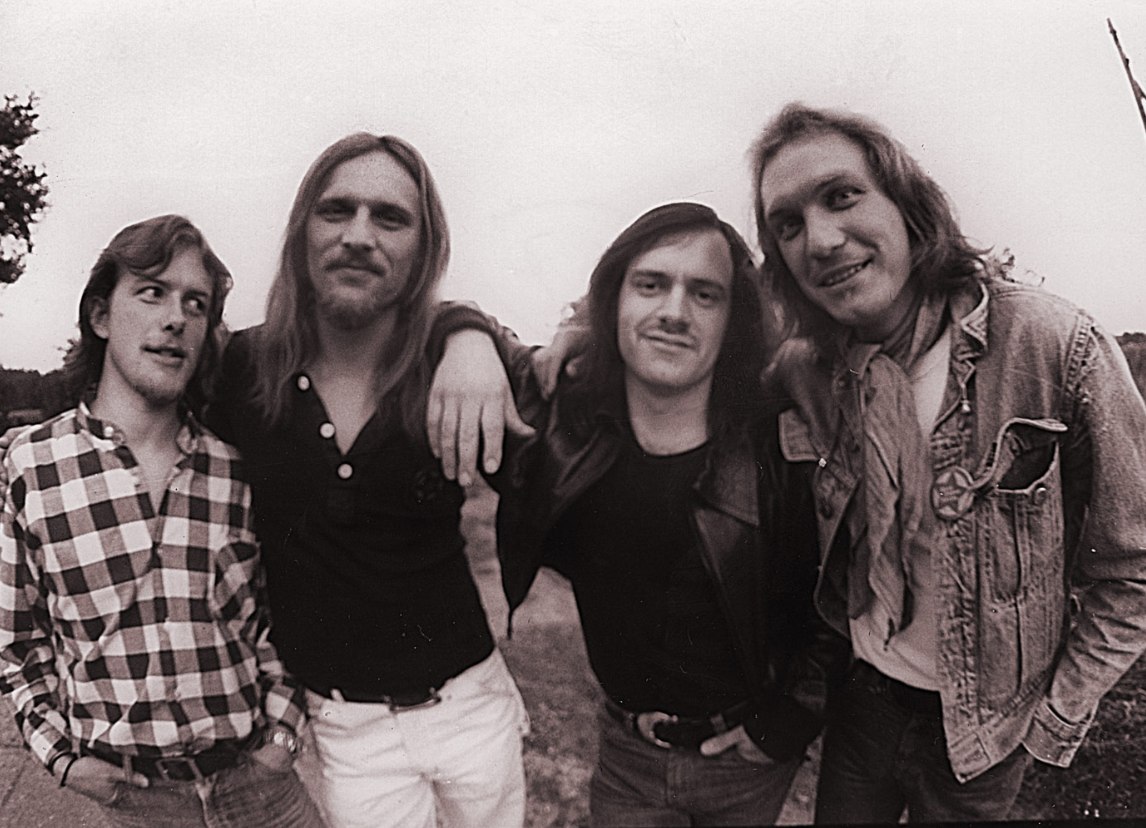
You were experimenting with a variety of styles. In 1980 you released (live) jazz fusion album.
That’s right. At least the musical priorities shifted here and there. This is still going on until today due to several reasons:
– the frequent change of musicians,
– the ongoing instrumental improvement of the supporting musicians,
– and above all, my interest to assemble young current rock and jazz-styles into our traditional Alcatraz characteristic.
However, the last point doesn’t include pop music for a reason. The importance of content, Alcatraz’s attitude to music and the clear demarcation to the mainly commercially orientated German pop has always been present throughout the band. That was especially important for me. That’s why in all over my 48 years of choosing new musicians, I’ve made sure that this basic principle is maintained. On top of that, especially as you get older, it’s very important to be interested in the new current music. Here is an example for you: Two years ago, I played for a couple of months in a death-metal band with 16-18-year old’s. I was 66 at that time. It always benefits a musician to try and play various styles. My constant goal as a drummer is, for example, to play difficult jazz-techniques in the hardness metal music used to be played. This improves the quality of the drumming lessons I give to younger people. Of course, this artistic attitude also means that you can only play for “minorities”. At the end the stupid mass, especially in the culturally still broken Germany, just listens to German pop and buys blood-empty musical pop-bullshit. The musical concept of the live-album ‘Trockeneis zum Frühstuck’ in 1980 evolved because Klaus Holst and I got bored of performing mainly at politician events. Especially as we personally mostly listened to Miles Davis, Frank Zappa, Mahavishnu Orchestra et cetera. That meant Holst and I wanted to change everything to have a pure fusion-program. We separated from Berghahn and Schulz, who were not satisfied with our musical direction, and checked for new members, again. Rainer Hansen joined us on the saxophone and transverse flute, Ralf Twellmann on the bass until 1980, afterwards Manfred Jakobs. Klaus Holst started the new compositions and worked together with me on the new arrangements with a lot of soloistic freedom for the stage.
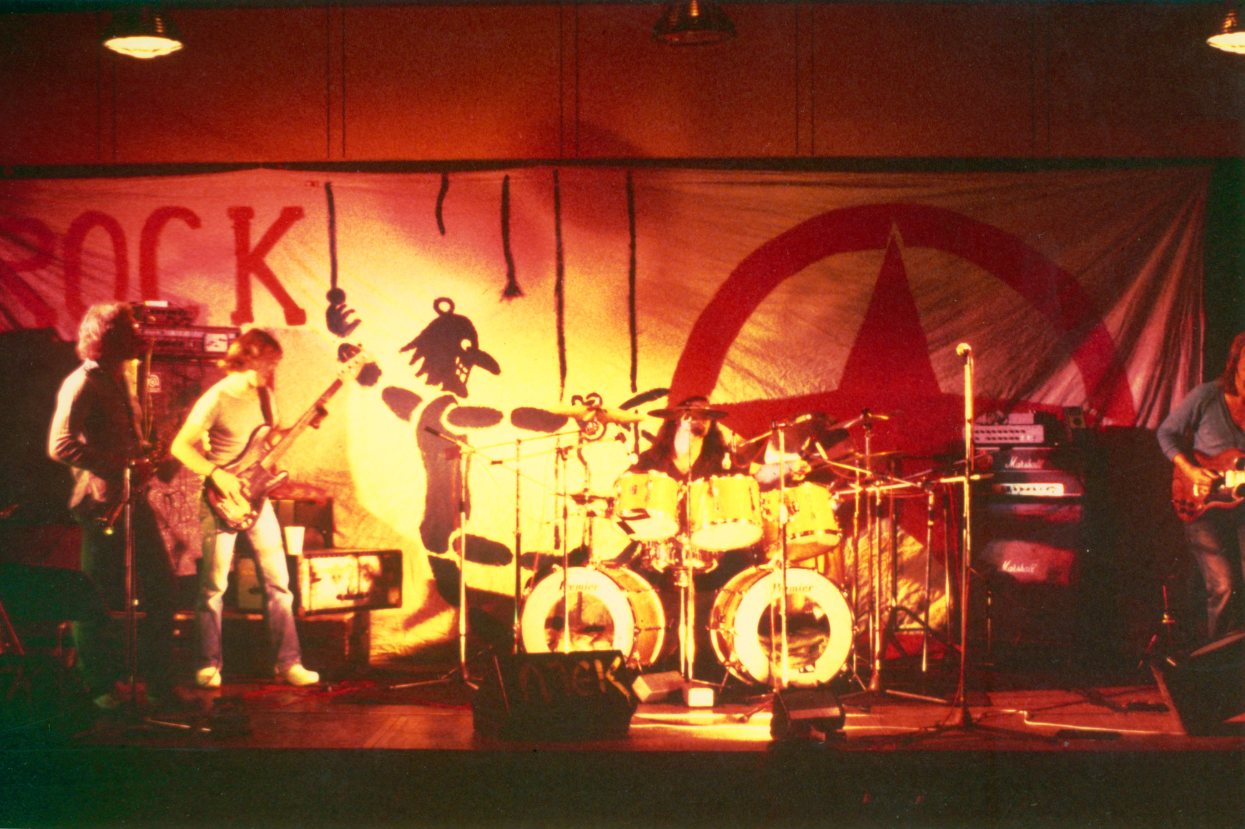
Tell us about the album that followed.
Our LP from 1982 is called ‘Alcatraz No.4’ (which is actually our fifth LP because of the late release of the recordings from ’76 on CD) and is recorded as a trio with slight percussion appearances. The A-side of the vinyl has the subtitle “In Rock,” the B-side “In Jazz”. In my view it’s one of the best Alcatraz LP’s. The base for this was our new member Mike Kann. Here we finally had a young bassist who not only brought the necessary hard play-style (hardcore funk to Latin jazz), but also showed great interest in the extreme fusion program. Mike also introduced his Latin-percussion’s (congas and timbales) to the music, and I added the first-time drums with sound addition effects. But please don’t confuse them with the awful e-drums, which the German studio philistines in the 80’s tried to replace the natural bass and drum instruments with, to finally renounce German rock music.
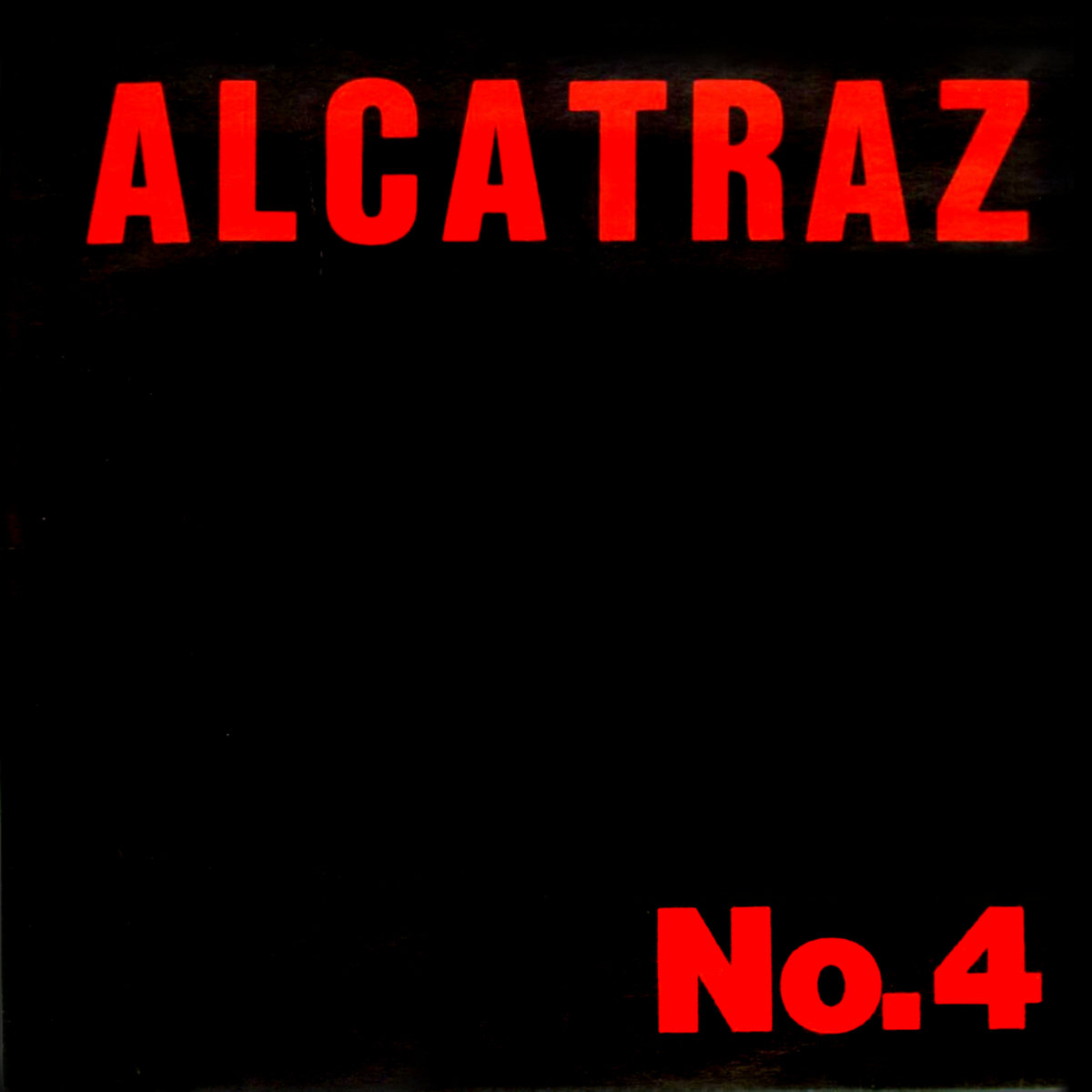
Mike stayed only barely two years back then, but he returned in the late ‘80s until the late 90’s and has been back on board since 2012. Between 1978 and 1985 we played many gigs all over Germany and abroad, especially with the trio of ‘No.4’. Such numerous gigs contribute to the fact that musicians, if they really give everything they have while on stage, as it is usual with us, improve their skill and quality consistently. Eventually this trio performed with an almost unbelievable stage power and seemed highly dominant especially on festivals with many bands. Although it was just an instrumental trio. In the meantime, I had taken over the live-management for the band and also ran the live-management for three more bands where I played the drums: An English reggae-band called Hypertension, a German new-wave-band Hinterbergers Wut and a rhythm and blues-combo Mojo Baby.
‘Last Station’ followed in 1992 and then you released ‘Holm’ in 1998 and ‘Sound Factory Sessions’ in 2002.
That’s right ‘Gothic Jazz: Last Station’ followed in 1992. However, much more has happened between 1984 and 1992: After several live tours throughout Germany, Austria, Luxembourg and Denmark, Mike and Klaus left the band. Mike went back to the Hamburger Latin-rock scene and Klaus stopped completely for the moment. I then completely rebuilt the band to a quintet with Mario Menzerolf (soprano saxophone, guitar), Maik Walter (vocals, flute, saxophone, keyboards), Stefan Peter (piano), Ali Kuntschke (bass, vocals) and me on the drums. Again, we became a filigree band with exclusively our own pieces, which had a strong fusion-slope between rock-jazz, prog, funk. Bowie and Crimson. The band had several live shows, mainly in northern Germany. Mario had a lot of recorded improvisations from rehearsals and mixed them onto two CD’s: ‘Last Tango’ and ‘OstepAlive’ (both 1985). This lineup split apart in the same year. In the beginning of 1986, I started a heavy jazz-orientated Alcatraz trio with Mario Menzerolf (this time on the E-piccolo-bass) and Hannes Wienert (trumpet, tenor saxophone). We soon created a comprehensive instrumental program with plenty of room for jazzy improvisations for us 3 soloists. This lineup had very few live gigs, therefore we recorded a lot in the rehearsal room. In the end this was enough for 4 CD’s: ‘Flying Circus’ (1987), ‘Holm Summit’ (1987), ‘More Cuts’ (1987) and ‘M.E.K.-live’ (1988). The CD’s were released by Mario in his “punapau”- publishing house. The band split up in 1988 and at the same time Mike Kann (bass, percussion) came back. He brought along Peter Poison as a singer from one of his bands. In addition, co-founder Klaus Holst (guitar) shared interest again. The fifth musician that joined us was Phama John (keyboard, tenor saxophone, background-vocals). This cast played a rockier timbre with a nod to new-wave, jazz-rock, punk-jazz, Doors. It was more for rock stages and we did some live gigs in larger venues in Northern Germany. The band unfortunately did not make it to their own CD, because we broke up again in early 1990. A studio-demo CD from 1989 has just been found again. Mike Kann, Phama John and I stayed together and the guitarist Matthias Petzel from Phama’s old band joined us. We developed a new quartet-program with the vocals from Phama and for the first time also of Mike. Unlike our previous lineup, the overall musical direction was much more radical. We also only played our own compositions. They were heavily influenced by the new speed-punk, the hardcore at that time (Rollins, Bad Brains, Melvins) as well as free-jazz. We performed them in a very rough way and this lineup lasted for one year. In 1991 Hannes Wienert (trumpet, tenor-saxophone) joined Alcatraz again and we worked on the program for the already mentioned CD ‘Gothic Jazz: Last Station’. It was mainly recorded by Mike and me in 1992-1993. Mike added powerful additional effects to his bass sound, took over the lead vocals and treated the fuzz-bass as a fast-paced solo instrument. I started writing books in 1983 and published them in 1993: ‘Allein unter Flaschen’ (Poems) + ‘Dummgelaufen’ (Stories). They fitted very well to the mood of Mike’s gothic-vocals, to which I spoke a longer German death-poem. We also did this live then. Hannes Wienert played three tracks on the CD with very free jazzy solos on his instruments. After that, he left the band for health reasons and appeared here and then as a live guest. Klaus Holst (guitar) also appears as a guest on a track of the LP. Afterwards he played several live gigs with us again in the trio, especially at major rock festivals, where I also did some poetry readings with my books. In 1996 Phama John (this time only lead-vocals and tenor-saxophone) and Matthias Petzel (guitar) came back. So again, we were a rock quintet. The result was the program for the CD ‘Holm,’ which we finished in 1998. It again only contains its own compositions. The music of this quintet got even more characterized of the harder elements in the 90’s (influences like Tom Waits, Rage Against the Machine, Melvins, Biohazard, grunge), but there was still some elements of fusion-jazz, free-jazz and Zappa to hear. Additionally, we had German and English lyrics in the songs.
Are there any other releases that I’m not aware of?
After ‘Holm’ we released 8 more Alcatraz CD’s until 2011. You can find them on our Homepage www.alcatraz-band.de. One of the best, I think, is the CD ‘Sound Factory Session’ (2002). It was recorded in a very good Studio in Hamburg (Lutz Rahn / Sound Factory Studio). We recorded with David Wolf (baritone, alto-saxophone and percussions), Mike Kann (bass, vocals, percussions), and me on the drums. It is one of the jazziest Alcatraz releases with heaps of improvisational freedom for us three soloists and a high intensity between our interaction with each other. Our CD ‘Leidkultur’ is content-wise, very out of line, but still highly remarkable. It was written during the five years I lived in the Munich area (2004-2009). Our former singer Thomas Hockling also lived in Southern Germany (Baden-Württemberg) at that time and had his own studio. We only played in the studio, mostly as a duo but here and there with a Turkish guest on the guitar: Fiekred Akkaya. The music sounded more like movie or theater music with lyrical German texts which Thomas sang. In addition, Thomas and Mike Kann cut some session recordings from Hamburg into. In the same studio I recorded my Alcatraz drum-solo CD ‘Jan Rieck – Drums 2007’. It is taped completely uncut with the full TAMA-double-bass-drum set. In the spring of 2009, I returned to Hamburg. We put together the old band we had before Alcatraz (Jet Set Blues Band from 1968 to 1969) and played several gigs in Hamburg and Lower Saxony. Ronny Wilson was also on board again. In my new time in Hamburg I met a lot of new musicians again, for example the guitarist Peter Brusch who created together with Ronny (bass) and me the new Alcatraz-trio. The band played exceptionally fast paced fusion compositions from the 70’s (King Crimson, Jack Bruce, Jeff Beck, Billy Cobham, Patto, McLaughlin), which were rearranged in a new way and placed on our CD ‘Rock Jazz Heavies’ (2011). On top of that we compiled 4 more CD’s from studio improvisations called ‘Warm Ups 1-4’. The band played various gigs in the Hamburger area and split up in 2013. From 2013 on Mike Kann (bass, vocals) joined me again, as well as Hamburg prog-guitarist Thomas Kirschler. Together we founded the new Alcatraz (Gothic Jazz) as a trio. This band has some radical characteristics like mostly odd bars (7/4, 7/8, 11/4, 15/4, 17/8 et cetera), metal sounds orchestrated by jazz techniques and Mike’s gothic-vocals with very morbid lyrics. The band is currently busy creating a live bootleg CD from a gig in 2016. Parallel to this ongoing process further addition has emerged for our stage appearances. After the Alcatraz program (‘Rock Jazz Heavies’), a few guest musicians joined us in 2014 (Lutz Rahn / Hammond-organ, Peter Poison Brandes / vocals and Beate Jeroch / vocals). We called ourselves “Alcatraz and Friends” and interpreted some of the concert compositions from the 60’s and early 70’s (Nice, Cream, Vanilla Fudge, Emerson Lake and Palmer, Doors, Deep Purple). But as the various styles conflicted too much with each other, we decided to switch this lineup to an extra band under the name of “Isle of Classic Rock”. We still play until today with a strong program from that time (Beate Jeroch / vocals, Sven Wussow / guitar, Lutz Rahn / organ, Mike Kann / bass, Jan Rieck / drums). Since 2015 we have been running the second current Alcatraz project (“Jazz Machine”) as a trio with André Czarnotta (guitar, piano). We exclusively play instrumentals with half own compositions and half old pure jazz compositions (John Coltrane, Tony Williams, Herbie Hancock, Frank Zappa, Mahavishnu Orchestra), rearranged by us three soloists with long improvisation spaces. A DVD demo will soon be available on the Alcatraz website. We will also start to work on a CD soon.
Looking back, what was the highlight of your time in the band? Which songs are you most proud of? Where and when was your most memorable gig?
That’s very difficult to answer. Since Alcatraz had many phases, where there was space for improvisations, the individual songs played a minor role. The musical phases are more in the foreground, but they are hard to compare to each other because of the various styles. The most powerful releases from an artistic and musical point of view are ‘Alcatraz No.4’ (1982) and ‘Sound Factory Session’ (2002). Of course, this is also measured in relation to the time it was created. It is similar when I think about the gigs. There are concerts in small clubs up to major music festivals with several thousand visitors. A musically strong band reacts with what they play automatically on the premises, the audience, the weather, the form of the day et cetera. I remember a concert we played in a medium sized restaurant in South-Bavaria in Murnau (close to Garmisch-Partenkirchen in the Alps). We stopped there during a tour with the Alcatraz-fusion lineup from 1983. So, there were also a few local farmers in the crowd who enjoyed their beer after work and obviously couldn’t connect with our music as you could see by the look on their faces. When I played my extensive drum solo at the end of the first set, physically putting in everything I had with a double-bass and eight toms, they seemed to become aware. When I was done and the whole room stank of my sweat, an enthusiastic applause broke out. Afterwards, three of the farmers ordered me to their table and started to give me free beers and admitted that our music was difficult to understand for them, but after they heard my drum solo they decided that they want to give me an offer to work with them, on the field to harvest crops. They said that they could use somebody that is so powerful like me… I felt that was a big compliment.
Is there any unreleased material?
Yes, we have collected around 30 live gig recordings from our professional time 1979 – 1985. I just don’t know what to do with it yet…
What were some of the bands you enjoyed in the 1960s and 1970s?
Oh dear! You know, there are so many in the different styles and historical phases of rock and jazz. I already named some bands from the 60’s and 70’s in the first half of this interview. If I look at the strengths of the respective decades, I come to the conclusion that the 60’s, especially the five years between 1967 and 1972, were the most creative years. This is already due because of the intense clash of various elements such as:
– Jazz, especially modal jazz (Miles Davis, John Coltrane) and free jazz (Ornette Coleman, Don Cherry) as well as the Germans Peter Brötzmann and Albert Mangelsdorf with both very political orientations.
– The mixes of English rock (blues-rock, psychedelic, fusion, experimental)
– Latin rock (Santana)
– Hard rock (Deep Purple, Led Zeppelin, Black Sabbath, Blue Cheer)
Ultimately, these mixtures led to a kind of “World Music,” in which the next few years more and more influences from all continents have been included (Mahavishnu Orchestra, Carla Bley Band, Gato Barbieri). The second most creative decade for me is the 90’s. For the first time I learned a lot from younger musicians with their sometimes dark styles and heavy sounds like grunge, trash- and death-metal, gothic, drum and bass, new prog, crossover et cetera. Listening regularly to this music automatically improved my drumming skills drastically. I’m getting 68 years old now and it is incredible that I can still improve my current skills with this method. The same goes for Mike Kann, my bassist. At the age of 61 he is still going nuts on his instrument too.
Let’s end this interview with some of your favorite albums.
I have the greatest respect for albums that are kind of a timeless, closed complete artwork. Of course, they exist in all decades. Here are some examples:
Miles Davis: ‘Kind of Blue’ (59), ‘Sketches of Spain’ (60), ‘E.S.P.’ (65), ‘Bitches Brew’ (70), ‘Miles Davis at Fillmore Live’ (70), ‘Live Evil’ (71), ‘On the Corner’ (72), ‘Star People’ (83)
John Coltrane: ‘Giant Steps’ (59), ‘Impressions’ (61), ‘A Love Supreme’ (64), ‘Ascension’ (65)
Art Blakey: ‘The African Beat’ (62)
The Beatles: ‘With the Beatles’ (63), ‘Rubber Soul’ (65), ‘Revolver’ (66), ‘Sgt. Pepper’s Lonely Hearts Club Band’ (67)
The Rolling Stones: ‘Around and Around’ (64 / deutsche Ausgabe), ‘Between the Buttons’ (67), ‘Sticky Fingers’ (71)
The Yardbirds: ‘Having a Rave Up with the Yardbirds’ (65)
The Byrds: ‘Mr. Tambourine Man’ (65)
The Pretty Things: ‘Get The Picture?’ (65)
The Who: ‘A Quick One’ (66)
The Kinks: ‘Face to Face’ (66)
Spencer Davis Group: ‘Autumn 66’ (66)
John Mayall’s Bluesbreakers: ‘Bluesbreakers with Eric Clapton’ (66), ‘A Hard Road’ (67), ‘Crusade’ (67), ‘Bare Wires’ (68)
Frank Zappa / Mothers: ‘Freak Out’ (66), ‘Hot Rats’ (69), ‘Fillmore East’ (71), ‘Over-Nite Sensation’ (73), ‘Roxy & Elsewhere’ (74), ‘One Size Fits All’ (75), ‘Zappa in New York’ (78), ‘Sheik Yerbouti’ (79), ‘You Are What You Is’ (81), ‘You Can’t Do That On Stage Anymore Vol.1~6’ (88-92), ‘The Yellow Shark’ (93)
Cream: ‘Fresh Cream’ (66), ‘Disraeli Gears’ (67)
Fleetwood Mac: ‘Fleetwood Mac’ (67)
The Remo Four: ‘Smile!’ (67)
Traffic: ‘Mr. Fantasy’ (67)
Procol Harum: ‘A Whiter Shade of Pale’ (67)
The Doors: ‘The Doors’ (67), ‘Waiting for the Sun’ (68), ‘Absolutely Live’ (70), ‘L.A. Woman’ (71)
Jimi Hendrix Experience: ‘Are You Experienced’ (67), ‘Axis: Bold as Love’ (67), ‘Electric Ladyland’ (68), ‘Band of Gypsys’ (70 / Live)
Carla Bley: ‘A Genuine Tong Funeral’ (67 / with Gary Burton), ‘Escalator over the Hill’ (68-71), ‘Musique Mecanique’ (78), ‘Fictitious Sports’ (81 / with Nick Mason)
The Small Faces: ‘There Are But Four Small Faces’ (68 / comp.), ‘Ogdens’ Nut Gone Flake’ (68)
The Nice: ‘Ars Longa Vita Brevis’ (68)
Ten Years After: ‘Undead’ / live (68)
Jethro Tull: ‘This Was’ (68)
Spooky Tooth: ‘It’s All About’ (68), ‘Spooky Two’ (69)
Soft Machine: ‘Soft Machine’ (68), ‘Third’ (70)
Jeff Beck (Group): ‘Truth’ (68). ‘Rough and Ready’ (71). ‘Wired’ (76)
Keef Hartley Band: ‘Halfbreed’ (69)
Taste: ‘Taste’ (69)
Tony Williams Lifetime: ‘Emergency I + II’ (69). ‘Turn It Over’ (70). ‘Believe It’ (75)
Jack Bruce: ‘Songs for a Tailor (69). ‘I’ve Always Wanted to Do This’ (80)
King Crimson: ‘In the Court of the Crimson King’ (69). ‘Lizard’ (70). ‘Starless and Bible Black’ (74). Red (74), ‘The Construkction of Light’ (2000), ‘The Power to Believe’ (03)
Colosseum: ‘Valentyne Suite’ (69), ‘Daughter of Time’ (70)
John McLaughlin: ‘Extrapolation’ (69), ‘Where Fortune Smiles’ (70)
Emerson, Lake and Palmer: ‘Emerson, Lake and Palmer’ (70)
Keith Tippett Group: ‘Dedicated to You, but You Weren’t Listening’ (70)
Led Zeppelin: ‘Led Zeppelin’ (69), ‘Led Zeppelin II’ (70)
Don Ellis: ‘Don Ellis at Fillmore’ (70)
Jean-Luc Ponty: ‘King Kong’ / ‘Music of Frank Zappa’ (70)
Deep Purple: ‘In Rock’ (70), ‘Fireball’ (71)
Cactus: ‘Cactus’ (70), ”Ot ‘n’ Sweaty’ (72)
Chick Corea: ‘Is’ (69), + Return to forever: ‘Where Have I Known You Before’ (74), ‘Romantic Warrior’ (76)
Santana: ‘Santana III’ (71)
Mahavishnu Orchestra: ‘The Inner Mounting Flame’ (71), ‘Birds of Fire’ (73), ‘Between Nothingness & Eternity’ (73)
McCoy Tyner: ‘Sahara’ (72), ‘Enlightenment’ (73)
Gil Evans: ‘Svengali’ (73)
Gato Barbieri: ‘Viva Emiliano Zapata’ (74)
Billy Cobham: ‘Crosswinds’ (74), ‘Total Eclipse’ (74)
Weather Report: ‘Mysterious Traveller’ (74), ‘Black Market’ (76), ‘Heavy Weather’ (77), ‘8:30 Live’ (79)
Shakti: ‘Shakti with John Mclaughlin’ (75)
Larry Coryell + Eleventh House: ‘Level One’ (75)
Albert Mangelsdorf, Jaco Pastorius, Alphonse Mouzon: ‘Trilogue Live’ (76)
Jaco Pastorius: ‘Jaco Pastorius’ (76)
Iggy Pop: ‘The Idiot’ (77), ‘Instinct’ (88)
David Bowie: ‘Heroes’ (77), ‘Let’s Dance’ (83), ‘Tin Machine’ (89), ‘First Outside’ version 2 (96)
Police: ‘Regatta de blanc’ (79)
Joy Division: ‘Unknown Pleasures’ (79), ‘Closer’ (80)
XTC: ‘Drums and Wires’ (79), ‘Black Sea’ (81)
Cure: ‘Seventeen Seconds’ (80)
Fischer Z: ‘Going Deaf For a Living’ (80), ‘Red Skies Over Paradise’ (81)
Siouxsie and the Banshees: ‘Juju’ (81)
Killig Joke: ‘What’s This For’ (81)
Odean Pope Trio: ‘Almost Like Me’ (82)
Mink de Ville: ‘Where Angels Fear to Tread'(83)
Nick Cave and the Bad Seeds: ‘Your Funeral… My Trial’ (86)
Watchtower: ‘Control and Resistance’ (89)
Sisters of Mercy: ‘Vision Thing’ (90)
John Zorn: ‘Naked city’ (90), ‘Kristallnacht’ (93)
Metallica: ‘Metallica’ (91)
Bad Brains: ‘Quickness’ (89), ‘God of Love’ (95)
Melvins: ‘Bullhead’ (91), ‘Houdini’ (93), ‘Stag’ (96), ‘The Maggot'(99)
Rage Against the Machine: ‘Rage Against the Machine’ (92)
Pantera: ‘Vulgar Display of Power’ (92), ‘Far Beyond Driven’ (94)
Nirvana: ‘Nevermind’ (91), ‘In Utero’ (93)
Prodigy: ‘Music for the Jilted Generation’ (94), ‘The Fat of the Land’ (97)
Machine Head: ‘Burn My Eyes’ (94), ‘The More Things Change…'(97), ‘The Burning Red’ (99), ‘Supercharger’ (01)
Voivod: ‘Negatron’ (95)
Alice in Chains: ‘Alice in Chain’ (95)
Biohazard: ‘Mata Leão’ (96)
Tool: ‘Ænima’ (96), ‘Lateralus’ (01), ‘10,000 Days’ (06)
Chemical Brothers: ‘Dig Your Own Hole’ (97)
Pearl Jam: ‘Yield’ (98)
Fun-Da-Mental: ‘Erotic Terrorism’ (98)
Unkle: ‘Psyence Fiction’ (98)
Type O Negative: ‘World Coming Down'(99)
Nine Inch Nails: ‘The Fragile’ (99)
Muse: ‘Absolution’ (03), ‘The Resistance’ (09)
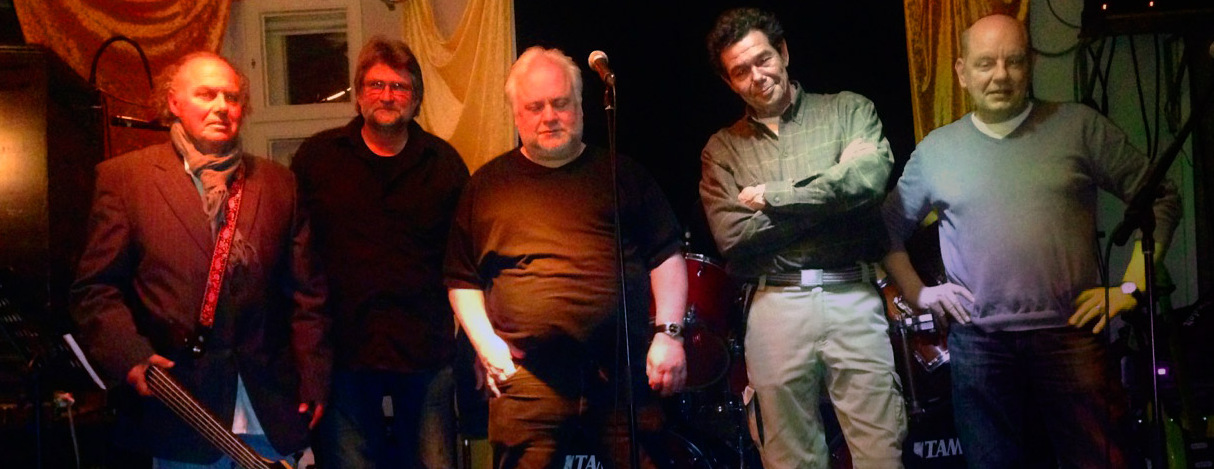
Thank you for taking your time. Last word is yours.
I hope we can come to you and play in Slovenia with one of our current Alcatraz lineups. A poetry reading in German wouldn’t make much sense, right? Anyhow, we would be very happy (unfortunately we won’t get younger) if we can make this happen, and also learn something about your culture. I also feel a bit sorry for you translator, as I delivered much more text than I expected. Musical greetings from Hamburg.
Klemen Breznikar
Very special thanks to Jannik Ehrenfried for translation.
German (original) version
Wo und wann bist du aufgewachsen? War Musik ein wichtiger Teil Ihres Familienlebens? Hat Sie die lokale Musikszene beeinflusst oder zum Musizieren inspiriert?
Jan Rieck: Ich kam im November 1950 in Hamburg zur Welt. Meine Mutter war zur Hälfte Kubanerin und Kindergärtnerin, mein Vater zur Hälfte Italiener und LKW-Fernfahrer. Also bin ich per Herkunft nur halber Deutscher, Viertel-Italiener und Viertel-Kubaner.
Ich bin die ersten 7 Jahre im Arbeiter-Viertel in Hamburg-Wandsbek aufgewachsen. Dann sind meine Eltern mit mir wegen eines Berufswechsels meines Vaters in die Elbvororte umgezogen.
Musik hatte bis dahin keine große Rolle in meiner Familie gespielt. Die lokale Musik-Szene spielte bei meiner Entscheidung, Schlagzeug zu spielen, überhaupt keine Rolle. Das mag auch daran liegen, dass die deutsche Kultur, die ehemals bis 1933 und Hitlers Machtübernahme hervorragend und avantgardistisch dastand, eben ab 1933 komplett zerstört wurde, was sogar heute noch grausam zu spüren ist: Sämtliche starken Künstler aus allen Bereichen waren ins Ausland vertrieben worden (Bücherverbrennungen) oder im KZ gelandet. Daraus folgte bis heute, dass z.B. die Produktionen der deutschen Unterhaltungsmusik im Weltverhältnis eher sechst-klassig dasteht… und das sind die alten, lahm-arschigen “Künstler”, die nach wie vor die großen Bühnen bevölkern (Lindenberg, Maffay, Westernhagen, Grönemeyer, Fischer usw.).
Mein Ur-Erlebnis mit der Musik waren im meinem Alter von 12 Jahren die frühen Beatles (“Roll over Beethoven” und “I wantto hold yourhand”). Diese Single-Vinyl-Platte hörte ich das erste Mal in einem Schallplatten-Geschäft. Ich hielt mir die beiden Kopfhörer (sie sahen aus wie Telefone, nur ohne Mikrofon-Teil) an die Ohren und war sofort elektrisiert. Es war der Band-Sound der Beatles, der sich von aller anderen Unterhaltungsmusik unterschied. Diesen geschlossenen Sound gab es vorher nicht einmal bei den amerikanischen Rock-and-Rollern wie Presley usw. Es wurde mir schnell klar, dass es bei den alten Rock-and-Rollern nur um den Sänger ging, während die Begleit-Bands eben nur beliebig klangen. Das haben damals die englischen Bands völlig umgedreht. Das Neue war eben der Band-Sound.
Ein paar Wochen später sah ich die Beatles im TV und wunderte mich über das, was Ringo Starr da hinten tat. Und mir war sofort klar, dass ich genau das machen wollte: Schlagzeug spielen, und zwar mögiichst als Profi. Diese Entscheidung fällte ich bereits als 13jähriger… zum Leidwesen meiner Eltern, weil die natürlich merkten, dass mich ab da meine schulischen Leistungen nicht mehr interessierten.
Wann hast du angefangen, Musik zu machen? Was war Ihr erstes Instrument? Wer waren Ihre größten Einflüsse?
Ich bekam immerhin von meinen Eltern als 14 jähriger ein kleines, sehr billiges Schlagzeug zum Geburtstag geschenkt, und ich begann, täglich darauf zu üben. Ein Tonband-Gerät (Grundig TK19L) hatte ich dabei auf Ohrenhöhe und spielte die englische Musik einfach mit. Hier kamen zu den Beatles sehr schnell weitere Lieblings-Bands dazu: Rolling Stones, Animals, Kinks, Yardbirds, Who, Spencer Davis Group usw. Ab 1965 kamen die englischen Blues-Rock-Bands dazu: John Mayall’s Bluesbreakers, Cream, Fleetwood Mac… und dann natürlich Jimi Hendrix Experience. Den habe ich als 16 jähriger das erste Mal live im Hamburger Star-Club gesehen, und das riss bei mir alles weg.
Das Schlagzeug ist seitdem mein erstes und einziges Instrument, nur mit dem Unterschied, dass es damals eben sehr klein war. Erst ab 1968 fing ich an, die großen Double-Bass-Drum-Sets zu spielen. Diese Sets sind für mich bis heute immer noch eine große physische und musikalische Herausforderung… Ich hatte übrigens in meinem Leben nicht eine einzige Stunde Schlagzeug-Unterricht genommen, also alles Autodidakt erlernt beim Beobachten und Hören der englischen und amerikanischen Drummer.
Ich stand 1965 an meinem Instrument voll unter dem Einfluss der genannten englischen Gruppen. Der für mich wichtigste Schlagzeuger war damals Keith Moon von The Who. Da ich später, anstatt Schularbeiten zu machen, als 16 jähriger regelmäßig in Hamburgs Star Club und andere Live-Clubs ging, um mir die teilweise großartigen Bands anzusehen, kam ich zunehmend auf Drummer als Vorbilder wie Carmine Appice (Vanilla Fudge) und Jon Hiseman (Colosseum).
Bei welchen Bands wart ihr vor der Gründung von Alcatraz?
Es waren 1966-67 das Quartett “Memory Lane” mit 3 Mitschülern aus meiner Schulklasse. 1967 bis Ende 69 gab es die Besetzung von “Jet Set Blues Band”. Mit letzterer machten wir bereits zahlreiche Auftritte, hauptsächlich in Jugendzentren, Gemeindehäusern und auf Schulfesten.
Können Sie uns etwas über die Gründung der Band erzählen?
Im Frühjahr 1970 gründeten wir Alcatraz. Der musikalische Grundgedanke neigte sich den ab 67/68 dominanten Underground-und Fusion-Bands zu (Frank Zappa, Soft Machine, Remo Four, Keef Hartley Band, Colosseum), von denen wir Stücke oder Elemente übernahmen.
Alcatraz startete im März 1970 als Quartett: Kaus Holst (lead-git), Rüdiger Berghahn (piano, vocals), Ronny Wilson (bass, b-vocals) und mit mir an den Drums. Zur Jahreswende 70/71 kam Klaus Nagurski (tenor-sax, flute) hinzu sowie der Manager Willy Jahnke, der uns sofort auf Profi-Kurs brachte: Während wir mit dem Quartett eben vereinzelt die gleichen Auftrittsorte wie Jet Set Blues Band hatten, kamen wir mit Willy Jahnke in ganz Deutschland herum, teilweise in großen Veranstaltungshallen, Stadt-Theatern, großen Kinos. Wir tourten zu dem Zeitpunkt schon als Vorgruppe mit Bands wie Hardin & York, Ekseption, Pretty Things, Kraftwerk usw.
Wann und wo spielten Alcatraz ihren ersten Auftritt? Erinnern Sie sich an das erste Lied, das die Band spielte? Wie wurde die Band vom Publikum angenommen? In welchen Veranstaltungsorten spielte Alcatraz schon früh?
Der erste Alcatraz-Gig fand in einem kirchlichen Gemeindehaus statt. Damals veranstalteten diese Häuser häufig Rock-Konzerte mit lokalen Bands für die lokalen Jugendlichen.
Der zweite Gig lief im Grenzdorf zur damaligen DDR, Helmstedt. Es war ein Open-Air-Band-Wettbewerb. Ich weiß noch, dass die Bühne dort keine Überdachung hatte, und dass wir im strömenden Regen auftraten. Bei jedem Schlag auf die Toms oder die Snare-Drum sprang mir das Wasser entgegen, und Rüdiger Berhahn konnte unter der Holzplatte seines E-Pianos Papier-Schiffchen schwimmen lassen.
Wir haben den Wettbewerb trotzdem als Gewinner abgeschlossen, knapp vor einer Bremer Band. Wir hatte allerdings bei dem Einsammeln der Stimmzettel aus dem Publikum leicht betrogen.
Der erste Alcatraz-Song, wenn ich es recht erinnere, war “Sinning for you” von Keef Hartley Band, eine Blues-ähnliche Komposition im Shuffle-Rhythmus. In der Quintett-Formation fingen wir dann aber sehr schnell an, fast nur noch Eigenkompositionen zu spielen.
Wie haben Sie sich entschieden, den Namen „Alcatraz“ zu verwenden?
Ich glaube, der Name wurde von Rüdiger vorgeschlagen aufgrund unserer solidarischen Haltung zu den Sioux-Indianern, die 1964 und 1969 die Insel Alcatraz in Kalifornien besetzten, um für die Einhaltung der Ihnen zugestandenen Verträge durch die US-Regierung zu demonstrieren.
Was hat den Sound der Band beeinflusst?
Der Alcatraz-Sound wurde von Anfang an von den internationalen Bands beeinflusst, die sich in den Bereichen Prog, Fusion, Underground bewegt haben. Wir sind alle regelmäßig in diese Konzerte gegangen. Es kam dann auch sehr schnell unsere Vorliebe für jazzigere Musik auf, die eben auch auf unsere Musik Einfluss nahm (Miles Davis, Carla Bley, Larry Coryell, John McLaughlin, Weather Report).
Hat sich das Publikum nach der Veröffentlichung Ihres Debüts vergrößert?
Es ist immer wichtig für eine Band auf Tour, wenn sie über ihr aktuelles Programm eine LP anbieten kann. Die Zusammenarbeit mit Willy Jahnke plus die “Vampire Statebuilding”-LP führten automatisch zu mehr Auftritten und mehr Publikum. Das war deutlich zu merken.
Wie sind Sie bei Philips unter Vertrag gekommen?
Das lief auch über Willy Jahnke, der zu einem Produzenten der Deutschen Grammophon Kontakt aufgenommen hatte. Dieser Produzent (Jimi Boyks) brachte uns im Oktober 1971 ins Studio. Später, als die LP abgemischt war, verkaufte Boyks wiederum diese Produktion an Philips und wechselte damit auch seinen Arbeitsplatz. Er war per sofort fester Produzent bei Philips.
Wie viele Exemplare des ersten Albums wurden gedruckt?
Ich weiß es nicht mehr genau. Ich glaube, es waren 3.000.
Was ist die Geschichte hinter deinem Debütalbum? Wo hast du es aufgenommen?
Wir taten das, was wir uns gleich für die erste LP vorgenommen hatten: Wir spielten ausschließlich Eigenkompositionen ein. Wir spielten die Stücke an drei Tagen ein (07. bis 11. Oktober 1971 mit jeweils mindestens 10 Stunden pro Tag inkl. Technik-Einstellungen). Es fand statt im Tonstudio Wümme, einem kleinen Ort in der Nordheide in Niedersachsen.
Das Equipment war eben unsere eigene Backline (Marshall-Amps, Premier-Drums, Gibson-Gitarre, Fender-Bass) sowie das Aufnahme-Equipment des Studios. Produzent war Jimi Boyks (s.o.).
Bitte teilen Sie uns Ihre Erinnerungen an die Sitzungen mit. Was waren die Einflüsse und Inspirationen für die aufgenommenen Songs?
Die musikalischen Einflüsse habe ich ja schon vorhin benannt. Die kamen natürlich auch bei den durchweg eigenen Stücken auf dieser LP zum Tragen. Die Durchführung der Sessions selber war teilweise schon sehr anarchistisch mit den vielen Blödeleien, die solche jungen Männer eben täglich von sich geben.
Es gab eine Szene während des zweiten Tages, die wir nicht vergessen werden: Ich war gerade beim Einspielen des Drum-Solos. Nach einigen Minuten tauchte direkt über meinen Hänge-Toms das Gesicht eines großen neugierigen Schäferhundes auf, der mich fixierte. Hinter dem Hund standen zwei Polizisten, einer mit einer Pistole im Anschlag auf mich, der andere sogar mit einer MP. Ich hörte auf zu spielen und nahm vorsichtshalber die Hände hoch.
Es stellte sich heraus, dass das ganze Einsatz-Kommando aus 12 bewaffneten Polizisten bestand, die von einem Wümme-Dorfbewohner den Tipp bekommen hatten, dass sich in den Studio-Räumen langhaarige junge Männer, Teile der RAF / Baader-Meinhof, befinden sollten. Sie hatten im zweiten Studio-Trakt des Hauses bereits den Schlagzeuger der dort aufnehmenden Underground-Band “Faust” verhaftet, weil der sich nicht ausweisen konnte. Wir hatten glücklicherweise unsere Ausweise dabei und wurden nach einer Stunde Einzelverhöre wieder in Ruhe gelassen.
Würden Sie uns Ihre Erkenntnisse zu den Titeln des Albums mitteilen?
Bei meiner Beurteilung der künstlerischen Ausrichtung der Tracks und ihrer Zusammenstellung muss man berücksichtigen, dass das jetzt 47 Jahre her ist. Ich war damals noch 20 Jahre alt, und die anderen Musiker lagen auch zwischen 18 und 22. Unter diesem Blickwinkel bin ich immer noch recht zufrieden mit dem Set, zumal wir diese Musik eben auch live aufgeführt haben.
Im Nachhinein hat ja die Firma “Long Hair Music”, die sich eben mit den Wiederveröffentlichungen des damaligen sogenannten “Kraut-Rock” beschäftigt, die erste Alcatraz-LP “Vampire Statebuilding” im Jahr 2002 nochmal als CD herausgebracht. Auf dieser CD erscheint noch eine Studio-Einspielung als Bonus Track (“Change will come”). Dieses Stück hatten wir mit anderen Stücken und einem anderen Bassisten als Demo gut ein Jahr später, also 1972, in einem anderen Studio in Hamburg eingespielt. Produzent hierfür war übrigens Jochen Petersen, der einige Jahre später reich wurde mit seiner Komposition “Sun of Jamaica”… so treffen die verschiedenen Welten eben manchmal zusammen.
Bei “Change will come” kann man natürlich schon eine deutliche Weiterentwicklung erkennen: Das Stück ist von der Komposition her wesentlich vielseitiger, spielerisch und Sound-technisch kompakter. Es freut mich im Nachhinein, dass dieses Stück auf diesem Weg wieder öffentlich gemacht wurde.
Wie zufrieden war die Band mit dem Sound des Albums? Was, wenn überhaupt, hätte sich Ihrer Meinung nach vom fertigen Produkt unterscheiden sollen?
Auf der “Vampire Statebuilding” waren für unseren Geschmack Gitarre und Bass viel zu dünn im Sound. Das Schlagzeug, speziell Bass-Drums und Toms, klangen zu sehr nach Garagen-Sound. Da haben wir damals live schon wesentlich besser geklungen. Andererseits hat das nicht den Stolz übertönt, den wir damals hatten wegen der ersten veröffentlichten LP.
Steckte hinter dem Album ein bestimmtes Konzept?
Beim Konzept war uns damals wichtig, die gesamte stilistische Bandbreite, die wir schon hatten, auf Vinyl zu bringen. Zu dieser Bandbreite gehörte auf jeden Fall, dass Rock- und Jazz-Elemente zusammenkamen, teilweise gemischt mit Zappa-ähnlichen, sehr schrägen Abläufen. Diese findet man vor allem im Titel-Song “Vampire State Building” vor, speziell in den mittleren Instrumentar-Teilen. Das war für deutsche Bands damals schon sehr avantgardistisch. Durch solche Parts haben wir uns damals deutlich unterschieden vom üblichen Kraut-Rock, zu dem wir sowieso nicht gehören wollten.
Wie wäre es mit deinem zweiten Album „Energie-Programm in Rock“?
Wir hatten zwischenzeitlich noch einen guten Live-Mitschnitt von 1976 auf Band gefunden. Er war live in einem Jugend-Club eingespielt. Und da wir häufig die Besetzung der Band, zumindest zum Teil, wechselten oder wechseln mussten, weil einzelne Alcatraz-Musiker hier und da eigene Bands als Band-Leader aufbauten, ist dieser Live-Mitschnitt eben auch teilweise mit neuen (Klaus Hormann am Bass, Thomas Hockling am Gesang und Harmonika) oder mit gerade wieder zurück gekehrten (Klaus Nagurskian Sax und Flute) Musikern aufgeführt worden. Weiterhin in der Band waren immer noch Klaus Holst (git), Rüdiger Berghahn (voc, piano) und ich. Es ergab also dieses Mal ein Sextett.
Wir haben dieses Material wesentlich später neu gemixt und als Live-CD herausgebracht. Titel: “Made in Germania”. Also wäre es diese CD, die rein geschichtlich gesehen unser zweites Album darstellt. Auf ihm hört man bereits den ersten Durchgang unserer deutschen Texte in den Stücken. Auch diese waren teilweise gesellschafts-politisch ausgerichtet, vor allem gegen das rechte Dreckspack in Deutschland und gegen das kulturlose Spießertum, auf die wir mit Alcatraz immer wieder getroffen sind.
Drum herum hatte die Musik in 1976 eine sehr kräftige Ausrichtung: Sound, Arrangements, und Eigenkompositionen, mehrstimmiger Gesang und auch viel Instrumental-Solistik, die sich anlehnte an Tony Williams Lifetime, Chick Corea, John McLaughlin, Zappa… aber auch mit leichten Kabarett-Noten.
“Energie-Programm in Rock” kam dann zwei Jahre später (1978) heraus als Studio-Produktion mit einem Quartett (Holst, Berghahn, Rieck) plus Ed Schulze am Bass. Die neuerliche Umbesetzung kam zustande, weil Hormann eine eigene eher rockig-poppige Band neu aufbaute… weil Nagurski auf Basis seines mittlerweile abgeschlossenen Studiums von Holz-Blas-Instrumenten zur Hamburger Philharmonie ging… und Hockling war verzogen Richtung Bayern aus beruflichen Gründen.
Da der neue Bassist Schulze am Bass etwas einfacher gestrickt war als seine beiden Vorgänger, und weil wir in punkto politischer Texte noch einmal gegen Atomkraftwerke nachlegen wollten, hat sich auch die musikalische Ausrichtung leicht verschoben. Wir sind mit diesem Anti-Atom-Programm ein Jahr lang landesweit häufig auf Demonstrationen und auch politischen Versammlungen der linken Szene aufgetreten.
Was sind einige der stärksten Erinnerungen an die Vorbereitung der Songs für das zweite Album?
Die Kompositionen waren weitgehend von Holst. Berghahn und ich schrieben fast alle Texte in Deutsch, die dann von Berghahn gesungen wurden. Diese Texte sind von uns in ein Gesamtkonzept arrangiert worden. Dieses Konzept hatte eine logische Reihenfolge, mit der die Verlogenheit der deutschen Atom-Betreiber und ihrer gekauften Politiker entlarvt wurden.
Insofern haben wir auch bei Auftritten vor sehr oft großer links-politischer Kulisse den Ablauf der Platte live so belassen. Es war wie eine Art Rock-Oper. An diesem Gesamtkonzept mit immer wieder getroffenen Neuordnungen haben wir während der Vorbereitung sehr ernsthaft arbeiten müssen.
Wir haben dann die LP in unserem Übungsraum eingespielt mit einem befreundeten Musiker, Kalla Wefel von der Hamburger Band “Oktober”, der seine Studio-Technik bei uns hierfür einbaute, und der dann den Mix übernahm.
Würden Sie uns Ihre Erkenntnisse zu den Titeln des Albums mitteilen?
Wie schon erwähnt, war hier der festgelegte Konzept-Ablauf wichtig. Wir haben die Sache sogar einige Wochen lang mit dem “Hamburger Eingreif-Theater” als Musik-Schauspiel ausgearbeitet. Das war eine Art linkes Straßen-Theater, das gewohnt war, ebenfalls auf Demonstrationen und politischen Protest-Veranstaltungen aufzutreten. Im Endeffekt haben diese Theater-Leute das nicht ganz hinbekommen. Sie waren nicht richtig in der Lage, mit solcher Musik umzugehen, und wir haben es dann als Band in Konzertform nach außen gebracht.
Sie haben mit verschiedenen Stilen experimentiert. 1980 haben Sie ein (Live-)Jazz-Fusion-Album veröffentlicht.
Das ist wohl richtig. Zumindest haben die musikalischen Schwerpunkte sich hier und da verlagert. Dies läuft bis heute so und liegt an mehreren Dingen:
– Der häufige Musiker-Wechsel
– Die laufende instrumentale Verbesserung der tragenden Musiker.
– Vor allem mein Interesse, neben unseren traditionellen Alcatraz-Stilistiken aktuelle, jüngere Rock- und Jazz-Stile einzubauen.
Bei letzteren Punkt spielt Pop-Musik allerdings überhaupt keine Rolle. Die inhaltliche Haltung von Alcatraz zur Musik und die deutliche Abgrenzung zum hauptsächlich kommerziell ausgerichteten deutschen Pop ist immer durchgehend vorhanden gewesen in der Band. Und das war besonders mir sehr wichtig. Ich habe deshalb in all den mittlerweile über 48 Jahren bei der Auswahl neuer Musiker dafür gesorgt, dass dieses Grundprinzip erhalten bleibt, und dass man sich, gerade wenn man älter wird, gefälligst mit der aktuellen jungen Musik zu beschäftigen hat.
Beispiel: Ich habe vor zwei Jahren einige Monate in einer Death-Metal-Band mit 16-18 jährigen gespielt, und da war ich auch schon 66 Jahre alt. Es hilft als Musiker immer weiter, sich mit verschiedenen Stilen zu beschäftigen. Hierbei ist mein dauerndes Ziel als Schlagzeuger, zum Beispiel schwierige Jazz-Techniken zu spielen in Metal-Härte… was wiederum der Qualität meines Schlagzeug-Unterrichts für Jugendliche zugutekommt.
Diese künstlerische Grundhaltung bedeutet natürlich auch, dass man immer nur für Minderheiten spielt. Die blöde Masse, vor allem im kulturell nach wie vor kaputten Deutschland, läuft eben doch nur zum “Schlager-Move” und kauft musikalisch Blut-leeren Pop-Mist.
Das spielerische Konzept für das Live-Album 1980 “Trockeneis zum Frühstück” kam vor allem zustande, weil Klaus Holst und ich keine Lust mehr hatten, hauptsächlich auf politischen Veranstaltungen zu spielen, während wir uns privat hauptsächlich mit Miles Davis, Frank Zappa, Mahavishnu Orchestra usw. beschäftigten.
D.h. Holst und ich wollten alles ändern zugunsten eines reinen instrumentalen Fusion-Programms. Wir haben uns von Berghahn und Schulze getrennt, die mit unseren spielerischen Vorstellungen nicht konform gingen, und die Band mal wieder neu besetzt. An Saxophon und Querflöte kam Rainer Hansen dazu, am Bass bis 1980 Ralf Twellmann, danach Manfred Jakob. Klaus Holst setzte sich an die neuen Kompositionen und machte mit mir die neuen Arrangements mit viel solistischem Freiraum für die Bühne.
Erzählen Sie uns von dem Album, das folgte.
Unsere 1982er-LP heißt “Alcatraz No. 4” (sie ist ja eigentlich unsere 5. LP wegen der späten Herausgabe der 76er CD), ist im Trio (git, bass, dr) eingespielt mit leichten Latin-Percussion-Einwürfen.
Die A-Seite der damals noch Vinyl-LP trägt den Untertitel “In Rock”, die B-Seite “In Jazz”. Die LP hat eigentlich mit Hard Rock wenig zu tun, wenn sie auch von allen drei Musikern sehr aufwändig mit hohem solistischem Einsatzegespielt ist. Sie ist aus meiner Sicht eine der besten Alcatraz-LPs.
Basis hierfür war der Neuzugang Mike Kann, der zu Klaus und mir dazu kam. Hier hatten wir endlich wieder einen jüngeren Bassisten, der nicht nur die nötige spielerische Härte mitbrachte (Hard-Core-Funk bis Latin-Jazz), sondern auch hohes Interesse zeigte am extremen Fusion-Programm. Dazu brachte Mike noch seine Latin-Percussion (Congas und Timbales) in die Musik ein und ich erstmalig Trommeln mit Sound-Zusatz-Effekten… letzteres bitte nicht verwechseln mit den furchtbaren E-Drums, mit denen die deutschen Studio-Spießer in den 80er Jahren versuchten, die natürlichen Bass- und Drums-Instrumente zu ersetzen, um die deutsche Rock-Musik endgültig zu entmündigen.
Mike ist zwar damals nur knapp zwei Jahre geblieben, ist aber in den späten 80ern wieder zurück gekehrt bis in die späten 90er und ist jetzt wieder an Bord seit 2012.
Wir hatten in der Zeit zwischen 1978 und 1985 sehr viele Gigs in ganz Deutschland und im Ausland, speziell eben mit dem Trio von “No. 4”. Auch solche zahlreichen Gigs tragen dazu bei, dass die Musiker, wenn sie sich in die Auftritte reinhängen, wie es bei uns üblich ist, zu laufenden spielerischen Qualitäts-Verbesserungen kommen. Dieses Trio hatte im Endeffekt eine fast unglaubliche Bühnenhärte und wirkte besonders auf Festivals im Rahmen der vielen Bands hoch dominant. Und dies, obwohl es sich nur um ein Instrumental-Trio handelte.
Ich hatte in der Zwischenzeit das Live-Management für die Band übernommen und betrieb zudem das Live-Management für drei weitere Bands, in denen ich Schlagzeug spielte: Eine englische Reggae-Band “Hypertension”, eine deutsche New-Wave-Band “Hinterbergers Wut” und eine Rhythm-and-Blues-Combo “Mojo Baby”.
„Last Station“ folgte 1992 und dann veröffentlichten Sie 1998 „Holm“ und 2002 „Sound Factory Sessions“.
Richtig: “Gothic Jazz: Last Station” folgte in 1992. Allerdings hat sich zwischen 1984 und 1992 noch einiges mehr getan: Nach mehreren Live-Tourneen durch ganz Deutschland sowie Österreich, Luxemburg und Dänemark verließen Mike und Klaus die Band. Mike ging wieder zurück in die Hamburger Latin-Rock-Szene und Klaus hörte vorerst ganz auf.
Ich habe daraufhin die Band komplett neu besetzt zu einem Quintett mit Mario Menzerolf (sopran-sax, git), Maik Walter (voc, flute, sax, keyboards), Stefan Peter (piano), Ali Kuntschke (bass, voc) und mir an den Drums. Es wurde wieder eine filigrane Truppe mit ausschließlich eigenen Stücken, die einen starken Fusion-Hang auswiesen zwischen Rock-Jazz, Prog, Funk, Bowie und Crimson. Die Band machte diverse Live-Auftritte, hauptsächlich in Nord-Deutschland. Mario hatte viele Mitschnitte von Impros der Band bei Übungs-Sessions und schnitt diese zu zwei CDs zusammen: “Last Tango” und “OsteAlive” (beide 1985). Diese Besetzung lief dann im selben Jahr wieder auseinander.
Anfang 1986 baute ich mit Mario Menzerolf (er stand dieses Mal am E-Picolo-Bass) und Hannes Wienert (trumpet, tenor-sax) ein stark Jazz-orientiertes Alcatraz-Trio auf. Wir schafften binnen Kürze ein umfassendes Instrumental-Programm mit viel Raum für jazzige Improvisationen für eben drei Solisten.
Diese Besetzung machte nur sehr wenige Live-Gigs, spielte dafür aber umso mehr im Probenraum ein. Dies reichte im Endeffekt für vier CD-Zusammenschnitte: “Flying Circus” (1987), “Holm Summit” (1987), “More Cuts” (1987), “M.E.K.-live”(1988). Diese CDs wurden von Mario in seinem punapau-Verlag herausgebracht.
Die Band trennte sich dann in 1988. Zugleich kam Mike Kann (bass, perc… siehe 1982-84) wieder dazu. Er brachte als Sänger aus einer seiner Bands Peter Poison Brandes mit. Zudem zeigte Mit-Gründer Klaus Holst (git) auch wieder Interesse. Als fünfter Musiker gesellte sich Phama John dazu (keyb, tenor-sax, b-voc).
Diese Besetzung spielte wieder ein rockigeres Timbre mit Anlehnung an New Wave, Jazz-Rock, Punk-Jazz, Doors). Sie war mehr etwas für Rock-Bühnen und machte einige Live-Gigs in größeren Veranstaltungs-Hallen in Nord-Deutschland. Die Band schaffte es leider nicht zu einer eigenen CD, weil sie sich schon Anfang 1990 wieder auflöste. Eine Studio-Demo-CD von 1989 wurde gerade wieder aufgefunden.
Mike Kann, Phama John und ich blieben zusammen, nahmen den Gitarristen Matthias Petzel aus Phamas voriger dazu und entwickelten ein neues Quartett-Programm mit den Vocals von Phama John und erstmals auch von Mike. Im Gegensatz zur vorigen Besetzung war die gesamte musikalische Ausrichtung deutlich radikaler. Man spielte ebenfalls nur eigene Kompositionen. Sie standen unter den neuen Einflüssen von Speed-Punk, dem damaligen Hard-Core (Rollins, Bad Brains, Melvins) sowie mit Free-Jazz-Einflüssen, und sie wurde mt sehr brachialer Spielweise aufgeführt. Diese Besetzung lief vorerst nur ein Jahr.
Ab 1991 stieß Hannes Wienert (trumpet, tenor-sax) wieder zu Alcatraz, und wir entwickelten das Programm für die bereits erwähnte CD “GothicJazz: Last Station”, die aber hauptsächlich im Duo zwischen Mike und mir im Studio eingespielt wurde (1992-93). Mike hatte seinen Bass-Sound ergänzt durch kräftige Zusatz-Effekte, übernahm die Lead-Vocals und behandelte den Fuzz-Bass als rasantes Solo-Instrument.
Ich hatte im Jahr 1983 angefangen, Bücher zu schreiben und brachte sie in 1993 heraus (“Allein unter Flaschen” / Gedichte) und “Dumm gelaufen” / Erzählungen). Sie passten sehr gut zur Stimmung vom Mikes Gothic-Vocals, wozu ich eben in Deutsch ein längeres Todes-Gedicht in die Musik sprach. Das machten wir dann auch live so.
Hannes Wienert spielte auf der CD drei Stücke mit sehr freien, jazzig-engagierten Soli auf seinen Instrumenten. Danach verließ er aus gesundheitlichen Gründen die Band und trat danach hier und da als Live-Gast auf. Klaus Holst (git) tritt bei einem Stück der LP ebenfalls als Gast auf, und er spielte danach mit uns wieder mal im Trio diverse Live-Gigs mit, vor allem auf größeren Rock-Festivals, bei denen ich wiederum zusätzlich Dichter-Lesungen mit meinen Büchern machte.
Im Jahr 1996 kamen dann wieder Phama John (dieses Mal nur lead-voc und tenor-sax) und Matthias Petzel (git) zurück, und wir waren wieder ein Rock-Quintett. Es entstand das Programm für die CD “Holm”, die wir in 1998fertigbekamen. Sie enthält wieder ausschließlich Eigenkompositionen. Die Musik dieses Quintetts war jetzt noch deutlicher geprägt von härteren Elementen der 90er Jahre (Einflüsse von Tom Waits, Rage againsttheMachine, Melvins, Biohazard, Grunge), aber es war immer noch etwas aus Fusion-Jazz, Free-Jazz und auch Zappa heraus zu hören. Zudem gab es deutsche und englische Texte in den Songs.
Gibt es weitere Veröffentlichungen, die mir nicht bekannt sind?
Nach “Holm” kamen noch acht weitere Alcatraz-CDs bis 2011. Du findest sie sowieso alle unter unserer Website alcatraz-band.de
Eine der besten ist, wie ich finde, die CD “Sound Factory Session” (2002). Sie ist in einem sehr guten Hamburger Studio (Lutz Rahn / Sound Factory Studio) eingespielt mit der Besetzung: David Wolf (bariton- und alto-sax, perc), Mike Kann (bass, voc, perc), Jan Rieck (drums). Sie gehört zu den jazzigsten Alcatraz-Releases mit viel Improvisations-Freiheiten für drei Solisten und hoher Intensität des Zusammenspiels.
Inhaltlich sehr aus der Reihe, aber auch bemerkenswert ist unsere CD “Leidkultur” (2005). Sie entstand während meiner fünf Jahre, die ich von 2004 bis 2009 im Münchner Raum zugebracht habe. Unserer früherer Sänger Thomas Hockling wohnte damals ebenfalls im Süden Deutschlands (BaWÜ) und hatte ein eigenes Studio eingerichtet. Wir spielten ausschließlich im Studio, überwiegend zu zweit, hier und da mit einem türkischen Gast an der Gitarre: Fiekred Akkaya: Die Musik grenzt eher an Film- oder Theater-Musik mit lyrischen deutschen Texten, die Thomas gesanglich umsetzte. Dazu setzte Thomas noch Sessions-Mitschnitte aus Hamburg (zusammen mit Mike Kann) rein.
Im selben Studio spielte ich dann noch meine Schlagzeug-Solo-CD “Jan Rieck – Drums 2007” als Alcatraz CD ein. Sie ist mit dem vollen TAMA-Double-Bass-Drumset eingespielt und komplett ungeschnitten live.
Ich kehrte im Frühjahr 2009 wieder nach Hamburg zurück. Wir stellten die alte Vorläufer-Band von Alcatraz, nämlich Jet Set Blues Band von 1968-69, zum Start zusammen, machten diverse Gigs in Hamburg und Niedersachsen. Hier war auch wieder Ronny Wilson mit an Bord.
Ich lernte in meiner neuen Hamburger Zeit wieder jede Menge Musiker kennen, u.a. den Gitarristen Peter Brusch, der dann zusammen mit Ronny am Bass und mir das neue Alcatraz-Trio ins Leben rief. Die Band spielte in sehr rasanter Form ausnahmsweise Fusion-Kompositionen aus den 70ern, die wir neu durch arrangierten (King Crimson, Jack Bruce, Jeff Beck, Billy Cobham, Patto, McLaughlin), die wir auf die CD “Rock Jazz Heavies” (2011) brachten. Zudem stellten wir aus Studio-Improvisationen noch weitere vier CDs (“Warm Ups” / 1 – 4) zusammen. Die Band spielte in den Jahren diverse Gigs im Hamburger Raum, und ging 2013 auseinander.
Ab 2013 war Mike Kann (bass, voc) erneut dabei. Dazu kam der Hamburger Prog-Gitarrist Thomas Kirschler, und wir gründeten die neue Alcatraz (Gothic Jazz) als Trio. Diese Band zeichnet sich aus durch einige Radikalitäten: Überwiegend schräge Takte (7/4, 7/8, 11/4, 15/4, 17/8 usw.), Metal-Sounds mit Jazz-Techniken instrumentiert, Mikes Gothic Vocals mit sehr morbiden Texten… Die Band ist gerade beschäftigt mit der Erstellung einer Live-Bootleg-CD eines Gigs aus 2016.
Parallel zu diesen Entwicklungen hat sich für Bühnen-Auftritte noch eine weitere Ergänzung ergeben: Nach dem Alcatraz-Programm (“Rock Jazz Heavies”) kamen ab 2014 noch Gastmusiker dazu (Lutz Rahn/Hammond-Organ, Peter Poison Brandes/voc, Beate Jeroch/voc) mit denen wir unter der Benennung “Alcatraz and Friends” einige der konzertanten Kompositionen aus den 60ern und Anfang 70ern (Nice, Cream, Vanilla Fudge, Emmerson Lake and Palmer, Doors, Deep Purple) interpretierten. Da hier die Stile dann doch zu sehr kollidierten, haben wir diese Besetzunz bald als Extra-Band geführt unter dem Namen “Isle of Classic Rock”. Sie spielt noch heute mit einem starken Programm aus jener Zeit (Beate Jeroch/voc, Sven Wussow/git, Lutz Rahn/organ, Mike Kann/bass, Jan Rieck/drums).
Ab 2015 läuft dazu parallel das zweite aktuelle Projekt Alcatraz (Jazz Machine) ebenfalls im Trio mit André Czarnotta (git, piano). Man spielt ausschließlich Instrumentals mit zur Hälfte Eigenkompositionen und zur anderen Hälfte ältere reine Jazz-Kompositionen (John Coltrane, Tony Williams, Herbie Hancock, Frank Zappa, Mahavishnu Orchestra), die das Trio mit drei Solisten jeweils neu arrangiert mit langen Improvisations-Räumen. Ein DVD-Demo erscheint demnächst in der Alcatraz-Web. Eine CD ist demnächst in Arbeit.
Was war rückblickend der Höhepunkt Ihrer Zeit in der Band? Auf welche Lieder bist du am meisten stolz? Wo und wann war Ihr denkwürdigster Auftritt?
Das ist sehr schwer zu beantworten. Da Alcatraz viele Phasen hatte, wo Freiraum für Improvisationen waren, spielen die einzelnen Songs häufig eine untergeordnete Rolle. Da stehen dann eher die musikalischen Phasen im Vordergrund, und die lassen sich wegen der unterschiedlichen Stile schlecht vergleichen.
Die aus künstlerischer und spielerischer Sicht vielleicht stärksten Releases sind “Alcatraz No. 4” (1982) und “Sound Factory Session” (2002). Dies ist natürlich auch gemessen im Verhältnis zur Zeit in denen sie entstanden sind.
Ähnlich ist es mit dem Vergleich der Gigs. Da gibt es Auftritte in kleinen Clubs bis hin zu Open-Air-Festivals mit mehreren Tausend Besuchern. Eine musikalisch starke Band reagiert mit dem, was sie spielt, automatisch auf die Räumlichkeiten, das Publikum, das Wetter, die Tagesform usw.
Ich kann mich an einen Auftritt in einer mittelgroßen Gebirgs-Gaststätte in Süd-Bayern in Murnau (in der Nähe von Garmisch-Partenkirchen in den Alpen) erinnern. Da waren wir während einer Tournee drin mit der Alcatraz-Fusion-Besetzung von 1983. Es waren auch einige einheimische Bauern im Publikum, die sich da ihr Feierabend-Bier gönnten und offenbar mit unserer Musik nichts anfangen konnten. Sie machten dementsprechende Gesichter. Als ich dann gegen Ende des ersten Sets mein ausgiebiges Schlagzeug-Solo spielte und dabei physisch alles reinlegte mit Double-Bass und acht Toms, wurden sie offenbar aufmerksam. Als ich fertig war und der ganze Raum nach meinem Schweiß stank, brandete ein begeisterter Applaus auf. Drei der Bauern bestellten mich an ihren Tisch, gaben mir Biere aus… dann gaben sie zu, dass unsere Musik für sie zwar schwer verständlich war… sie hätten aber mein Drum-Solo gehört und beschlossen, sie wollten mir ein Angebot machen, bei ihnen auf dem Feld zu arbeiten bei der Getreide-Ernte. Sie könnten jemanden, der so reinhaut, prima gebrauchen… Ich habe das als großes Lob empfunden…
Gibt es unveröffentlichtes Material?
Ja, wir haben aus der Profi-Zeit von 1979 – 1985 noch ungefähr 30 Live-Gig-Mitschnitte gesammelt. Ich weiß noch nicht, was ich damit anstellen soll…
Welche Bands mochten Sie in den 1960er und 1970er Jahren?
Ach herrjeh! Weißt Du, es sind so viele in den verschiedenen Stilen und geschichtlichen Phasen von Rock und Jazz. Ich habe ja schon einige aus den 60ern und 70ern in der ersten Hälfte dieses Interviews benannt.
Wenn ich mir die Stärken der jeweiligen Jahrzehnte betrachte, komme ich dazu, die 60er, speziell die fünf Jahre 1967-72, als die kreativsten Jahre zu beurteilen. Dies schon wegen des intensiven Aufeinandertreffens von Elementen wie…
– Jazz, speziell modaler Jazz (Miles Davis, John Coltrane) und Free-Jazz (Ornette Coleman, Don Cherry) sowie die deutschen Peter Brötzmann, Albert Mangelsdorf, alle mit sehr politischen Ausrichtungen.
– Die Mixe des englischen Rock (Blues Rock, Psychedelic, Fusion, Experimental)
– Latin Rock (Santana)
– Hard Rock (Deep Purple, Led Zeppelin, Black Sabbath, Blue Cheer)
Letztlich führten diese Mischungen zu einer Art “Weltmusik”, in der die nächsten Jahre immer mehr Einflüsse von allen Kontinenten einbezogen wurden (Mahavishnu Orchestra, Carla Bley Band, Gato Barbieri).
Das zweit-kreativste Jahrzehnt sind für mich die 90er. Ich habe in dem Jahrzehnt erstmalig unheimlich viel von jüngeren Musikern gelernt mit ihren teilweisen dunklen Stilen und fetten Sounds: Grunge, Trash- und Death-Metal, Gothic, Drum and Bass, New Prog, Crossover usw. Das regelmäßige Hören dieser Musik hat zudem automatisch mein Schlagzeug-Spiel drastisch erweitert. Ich werde jetzt 68 Jahre alt und mag es kaum glauben: Über diese Wege kann ich mein aktuelles Spielen immer noch erweitern. Dasselbe gilt übrigens für Mike Kann, meinen Bassisten. Auch der platzt mit 61 Jahren an seinem Instrument noch aus allen Nähten.
Lassen Sie uns dieses Interview mit einigen Ihrer Lieblingsalben beenden
Den größten Respekt habe ich vor Alben, die eine Art zeitloses, geschlossenes Gesamt-Kunstwerk hergeben. Die gibt es natürlich in allen Jahrzehnten. Beispiele:
Miles Davis: ‘Kind of Blue’ (59), ‘Sketches of Spain’ (60), ‘E.S.P.’ (65), ‘Bitches Brew’ (70), ‘Miles Davis at Fillmore Live’ (70), ‘Live Evil’ (71), ‘On the Corner’ (72), ‘Star People’ (83)
John Coltrane: ‘Giant Steps’ (59), ‘Impressions’ (61), ‘A Love Supreme’ (64), ‘Ascension’ (65)
Art Blakey: ‘The African Beat’ (62)
The Beatles: ‘With the Beatles’ (63), ‘Rubber Soul’ (65), ‘Revolver’ (66), ‘Sgt. Pepper’s Lonely Hearts Club Band’ (67)
The Rolling Stones: ‘Around and Around’ (64 / deutsche Ausgabe), ‘Between the Buttons’ (67), ‘Sticky Fingers’ (71)
The Yardbirds: ‘Having a Rave Up with the Yardbirds’ (65)
The Byrds: ‘Mr. Tambourine Man’ (65)
The Pretty Things: ‘Get The Picture?’ (65)
The Who: ‘A Quick One’ (66)
The Kinks: ‘Face to Face’ (66)
Spencer Davis Group: ‘Autumn 66’ (66)
John Mayall’s Bluesbreakers: ‘Bluesbreakers with Eric Clapton’ (66), ‘A Hard Road’ (67), ‘Crusade’ (67), ‘Bare Wires’ (68)
Frank Zappa / Mothers: ‘Freak Out’ (66), ‘Hot Rats’ (69), ‘Fillmore East’ (71), ‘Over-Nite Sensation’ (73), ‘Roxy & Elsewhere’ (74), ‘One Size Fits All’ (75), ‘Zappa in New York’ (78), ‘Sheik Yerbouti’ (79), ‘You Are What You Is’ (81), ‘You Can’t Do That On Stage Anymore Vol.1~6’ (88-92), ‘The Yellow Shark’ (93)
Cream: ‘Fresh Cream’ (66), ‘Disraeli Gears’ (67)
Fleetwood Mac: ‘Fleetwood Mac’ (67)
The Remo Four: ‘Smile!’ (67)
Traffic: ‘Mr. Fantasy’ (67)
Procol Harum: ‘A Whiter Shade of Pale’ (67)
The Doors: ‘The Doors’ (67), ‘Waiting for the Sun’ (68), ‘Absolutely Live’ (70), ‘L.A. Woman’ (71)
Jimi Hendrix Experience: ‘Are You Experienced’ (67), ‘Axis: Bold as Love’ (67), ‘Electric Ladyland’ (68), ‘Band of Gypsys’ (70 / Live)
Carla Bley: ‘A Genuine Tong Funeral’ (67 / with Gary Burton), ‘Escalator over the Hill’ (68-71), ‘Musique Mecanique’ (78), ‘Fictitious Sports’ (81 / with Nick Mason)
The Small Faces: ‘There Are But Four Small Faces’ (68 / comp.), ‘Ogdens’ Nut Gone Flake’ (68)
The Nice: ‘Ars Longa Vita Brevis’ (68)
Ten Years After: ‘Undead’ / live (68)
Jethro Tull: ‘This Was’ (68)
Spooky Tooth: ‘It’s All About’ (68), ‘Spooky Two’ (69)
Soft Machine: ‘Soft Machine’ (68), ‘Third’ (70)
Jeff Beck (Group): ‘Truth’ (68). ‘Rough and Ready’ (71). ‘Wired’ (76)
Keef Hartley Band: ‘Halfbreed’ (69)
Taste: ‘Taste’ (69)
Tony Williams Lifetime: ‘Emergency I + II’ (69). ‘Turn It Over’ (70). ‘Believe It’ (75)
Jack Bruce: ‘Songs for a Tailor (69). ‘I’ve Always Wanted to Do This’ (80)
King Crimson: ‘In the Court of the Crimson King’ (69). ‘Lizard’ (70). ‘Starless and Bible Black’ (74). Red (74), ‘The Construkction of Light’ (2000), ‘The Power to Believe’ (03)
Colosseum: ‘Valentyne Suite’ (69), ‘Daughter of Time’ (70)
John McLaughlin: ‘Extrapolation’ (69), ‘Where Fortune Smiles’ (70)
Emerson, Lake and Palmer: ‘Emerson, Lake and Palmer’ (70)
Keith Tippett Group: ‘Dedicated to You, but You Weren’t Listening’ (70)
Led Zeppelin: ‘Led Zeppelin’ (69), ‘Led Zeppelin II’ (70)
Don Ellis: ‘Don Ellis at Fillmore’ (70)
Jean-Luc Ponty: ‘King Kong’ / ‘Music of Frank Zappa’ (70)
Deep Purple: ‘In Rock’ (70), ‘Fireball’ (71)
Cactus: ‘Cactus’ (70), ”Ot ‘n’ Sweaty’ (72)
Chick Corea: ‘Is’ (69), + Return to forever: ‘Where Have I Known You Before’ (74), ‘Romantic Warrior’ (76)
Santana: ‘Santana III’ (71)
Mahavishnu Orchestra: ‘The Inner Mounting Flame’ (71), ‘Birds of Fire’ (73), ‘Between Nothingness & Eternity’ (73)
McCoy Tyner: ‘Sahara’ (72), ‘Enlightenment’ (73)
Gil Evans: ‘Svengali’ (73)
Gato Barbieri: ‘Viva Emiliano Zapata’ (74)
Billy Cobham: ‘Crosswinds’ (74), ‘Total Eclipse’ (74)
Weather Report: ‘Mysterious Traveller’ (74), ‘Black Market’ (76), ‘Heavy Weather’ (77), ‘8:30 Live’ (79)
Shakti: ‘Shakti with John Mclaughlin’ (75)
Larry Coryell + Eleventh House: ‘Level One’ (75)
Albert Mangelsdorf, Jaco Pastorius, Alphonse Mouzon: ‘Trilogue Live’ (76)
Jaco Pastorius: ‘Jaco Pastorius’ (76)
Iggy Pop: ‘The Idiot’ (77), ‘Instinct’ (88)
David Bowie: ‘Heroes’ (77), ‘Let’s Dance’ (83), ‘Tin Machine’ (89), ‘First Outside’ version 2 (96)
Police: ‘Regatta de blanc’ (79)
Joy Division: ‘Unknown Pleasures’ (79), ‘Closer’ (80)
XTC: ‘Drums and Wires’ (79), ‘Black Sea’ (81)
Cure: ‘Seventeen Seconds’ (80)
Fischer Z: ‘Going Deaf For a Living’ (80), ‘Red Skies Over Paradise’ (81)
Siouxsie and the Banshees: ‘Juju’ (81)
Killig Joke: ‘What’s This For’ (81)
Odean Pope Trio: ‘Almost Like Me’ (82)
Mink de Ville: ‘Where Angels Fear to Tread'(83)
Nick Cave and the Bad Seeds: ‘Your Funeral… My Trial’ (86)
Watchtower: ‘Control and Resistance’ (89)
Sisters of Mercy: ‘Vision Thing’ (90)
John Zorn: ‘Naked city’ (90), ‘Kristallnacht’ (93)
Metallica: ‘Metallica’ (91)
Bad Brains: ‘Quickness’ (89), ‘God of Love’ (95)
Melvins: ‘Bullhead’ (91), ‘Houdini’ (93), ‘Stag’ (96), ‘The Maggot'(99)
Rage Against the Machine: ‘Rage Against the Machine’ (92)
Pantera: ‘Vulgar Display of Power’ (92), ‘Far Beyond Driven’ (94)
Nirvana: ‘Nevermind’ (91), ‘In Utero’ (93)
Prodigy: ‘Music for the Jilted Generation’ (94), ‘The Fat of the Land’ (97)
Machine Head: ‘Burn My Eyes’ (94), ‘The More Things Change…'(97), ‘The Burning Red’ (99), ‘Supercharger’ (01)
Voivod: ‘Negatron’ (95)
Alice in Chains: ‘Alice in Chain’ (95)
Biohazard: ‘Mata Leão’ (96)
Tool: ‘Ænima’ (96), ‘Lateralus’ (01), ‘10,000 Days’ (06)
Chemical Brothers: ‘Dig Your Own Hole’ (97)
Pearl Jam: ‘Yield’ (98)
Fun-Da-Mental: ‘Erotic Terrorism’ (98)
Unkle: ‘Psyence Fiction’ (98)
Type O Negative: ‘World Coming Down'(99)
Nine Inch Nails: ‘The Fragile’ (99)
Muse: ‘Absolution’ (03), ‘The Resistance’ (09)
Vielen Dank, dass Sie sich die Zeit genommen haben. Das letzte Wort gehört dir.
Ich hoffe, wir können mit einer unserer aktuellen Alcatraz-Besetzugen mal bei Euch in Slowenien auftreten. Eine Dichterlesung in Deutsch hätte bei Euch ja wohl wenig Sinn, oder? Würde uns sehr freuen (wir werden leider nicht mehr jünger) … Und wir würden uns ebenfalls freuen, Euer kulturelles Umfeld kennen zu lernen. Zudem tut mir Euer Übersetzer ein wenig leid, da ich hier viel mehr Text abgelieferthabe, als erwartet. Musikalische Grüße aus Hamburg.

